Negros Island is home to a diverse array of bird species, making it an ideal location for bird-watching enthusiasts or anybody interested in the planet’s biodiversity.
With lush rainforests and mountains, Negros provides habitats for hundreds of avian species, including several endemic ones. These endemic bird species can only be found on the island, making Negros an important location for conservation efforts.
Bird watchers are provided with a unique opportunity to witness the beauty of these species in their natural surroundings, while also understanding the importance of preserving their habitat.
In this article, we will be exploring the different bird species found on Negros Island and gaining insight into their behavior and conservation status.
1. Orange-Bellied Flowerpecker
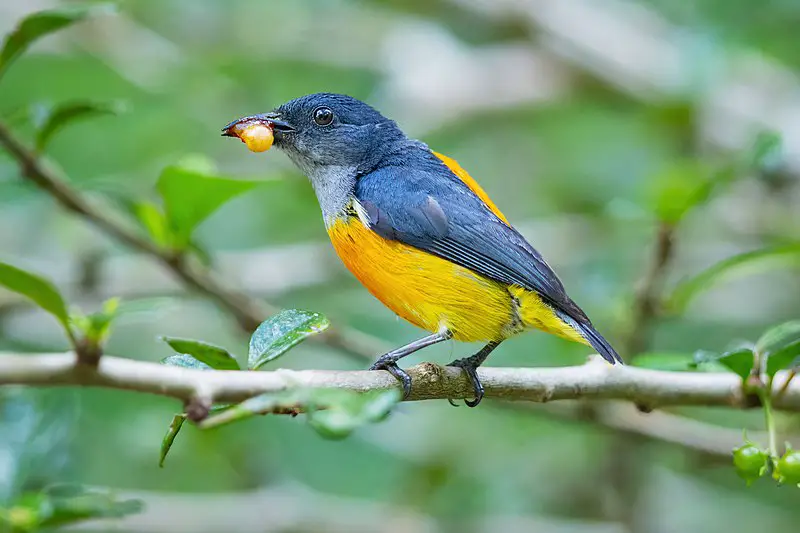
The orange-bellied flowerpecker is a small bird found in countries such as Bangladesh, Brunei, India and Thailand. It inhabits lowland forests, mangrove forests and montane forests.
Males of this species are quite distinctive with their bright orange bellies contrasting against the black head with white markings around the eyes.
They have green wings that feature yellow edging on the tips of their primaries and secondaries.
Their bill is short but stout for its size making it ideal for catching insects from branches or tree trunks during feeding sessions.
The female differs slightly in coloration having an olive crown instead of black one which makes them easier to identify when observed together within flocks or pairs .Scientific classification:
| Kingdom | Animalia |
| Phylum | Chordata |
| Class | Aves |
| Order | Passeriformes |
| Family | Dicaeidae |
| Genus | Dicaeum |
| Species | D. trigonostigma |
Also Featured In: Most Common Types of Bangladeshi Birds,
2. Olive-Backed Sunbird
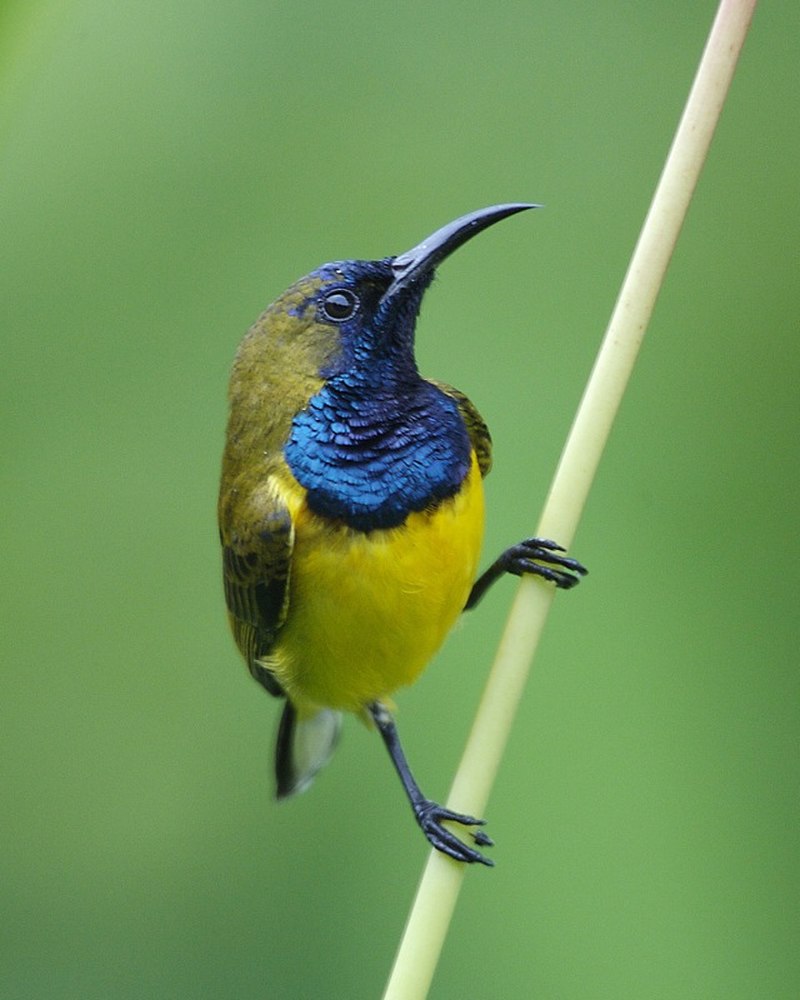
The Olive-backed Sunbird is a vibrant species of sunbird found in Southern Asia and Australia. Its striking yellow underbelly complements its olive upperparts, making it an attractive sight to behold.
First described by Mathurin Jacques Brisson in 1760 based on a specimen from the Philippines, this small songbird loves nectar but will also feed on insects as well as other tiny invertebrates.
It feeds mainly while hovering or perching with its bill pointing downwards – quite an impressive feat.
This bird has adapted to both forested areas and urban gardens meaning they can be seen all over their range.
With conservation efforts in place for this beautiful creature we are sure that the Olive-backed Sunbird will continue to bring joy to our lives for many years yet.Scientific classification:
| Kingdom | Animalia |
| Phylum | Chordata |
| Class | Aves |
| Order | Passeriformes |
| Family | Nectariniidae |
| Genus | Cinnyris |
| Species | C. jugularis |
Also Featured In: Birds of the Philippines, Queensland Birds You Should Know
3. Pied Triller
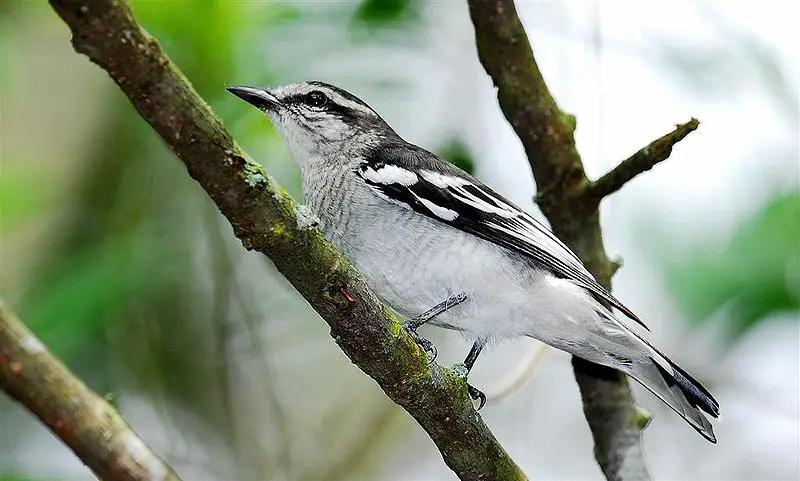
The Pied Triller is a species of bird found in parts of South East Asia. It belongs to the family Campephagidae and can be seen in Brunei, India, Indonesia, Malaysia, Philippines, Singapore and Thailand.
This black-and-white passerine has an eye patch that sets it apart from other birds its size. Its underparts are white with rufous upperparts and wings as well as grey crowns on both males and females giving them a unique look.
They mainly feed on insects but have also been observed eating fruits from trees or shrubs occasionally.
In terms of habitat they prefer forests but can adapt to secondary growth habitats too if needed for survival purposes making them quite adaptive creatures indeed.Scientific classification:
| Kingdom | Animalia |
| Phylum | Chordata |
| Class | Aves |
| Order | Passeriformes |
| Family | Campephagidae |
| Genus | Lalage |
| Species | L. nigra |
4. Yellow-Breasted Fruit Dove
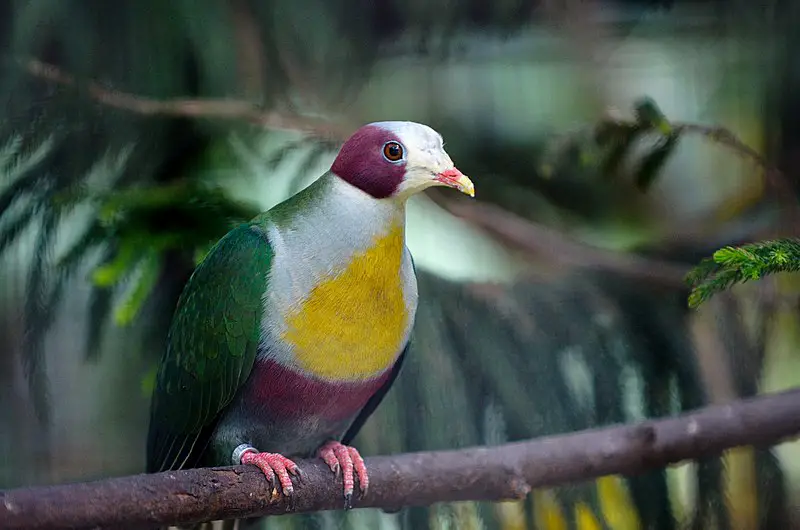
The Yellow-breasted fruit dove is a beautiful bird endemic to the Philippines. It lives in tropical moist lowland forests, however its population is declining due to habitat loss and illegal hunting or trapping for the wildlife trade.
This species has been listed as Least Concern by IUCN but conservation efforts are still needed if we want this species of bird survive.
The yellow-breasted fruit Dove has an overall yellowish colour with dark wings and tail feathers, red eyes and white spot on each side of their neck.
They feed mainly on fruits such as figs and berries which makes them important seed dispersers in their natural habitats while they also drink flower nectar like hummingbirds do.
Its illegal to hunt, capture or keep this lovely little creature so let’s all work together towards protecting it from extinction.Scientific classification:
| Kingdom | Animalia |
| Phylum | Chordata |
| Class | Aves |
| Order | Columbiformes |
| Family | Columbidae |
| Genus | Ptilinopus |
| Species | P. occipitalis |
5. Barred Rail
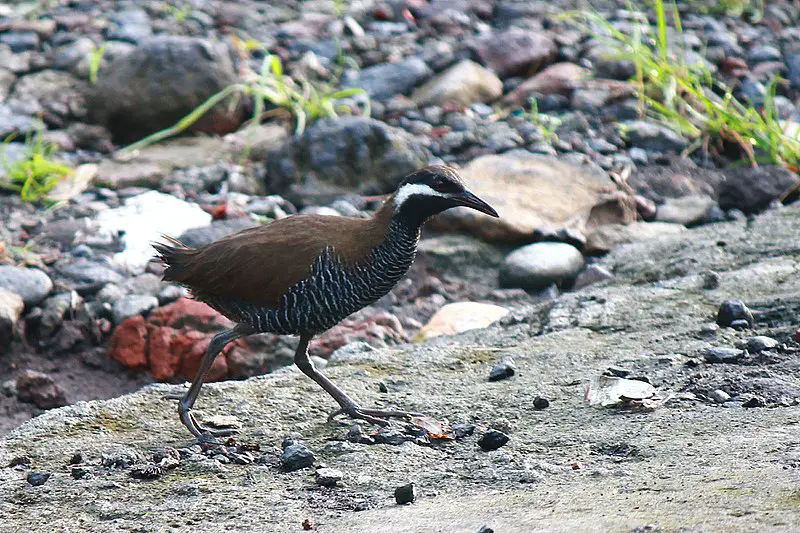
The Barred Rail is a species of rail found in the Philippines, Sulawesi and Salawati. It has distinct barred black and white feathers, making it easily identifiable.
This bird is common but shy, so it can be difficult to spot during its natural habitat. It prefers wet habitats such as marshes or rice fields that provide plenty of cover for them to hide from potential predators.
While their diet consists mainly of small invertebrates like earthworms and insects, they�ve also been known to feed on seeds and grains when food sources are scarce.
Though not endangered yet, human activity continues to reduce these birds’ already limited habitats across the region which may put them at risk if conservation efforts aren’t taken soon enough.Scientific classification:
| Kingdom | Animalia |
| Phylum | Chordata |
| Class | Aves |
| Order | Gruiformes |
| Family | Rallidae |
| Genus | Hypotaenidia |
| Species | H. torquata |
6. Philippine Pygmy Woodpecker
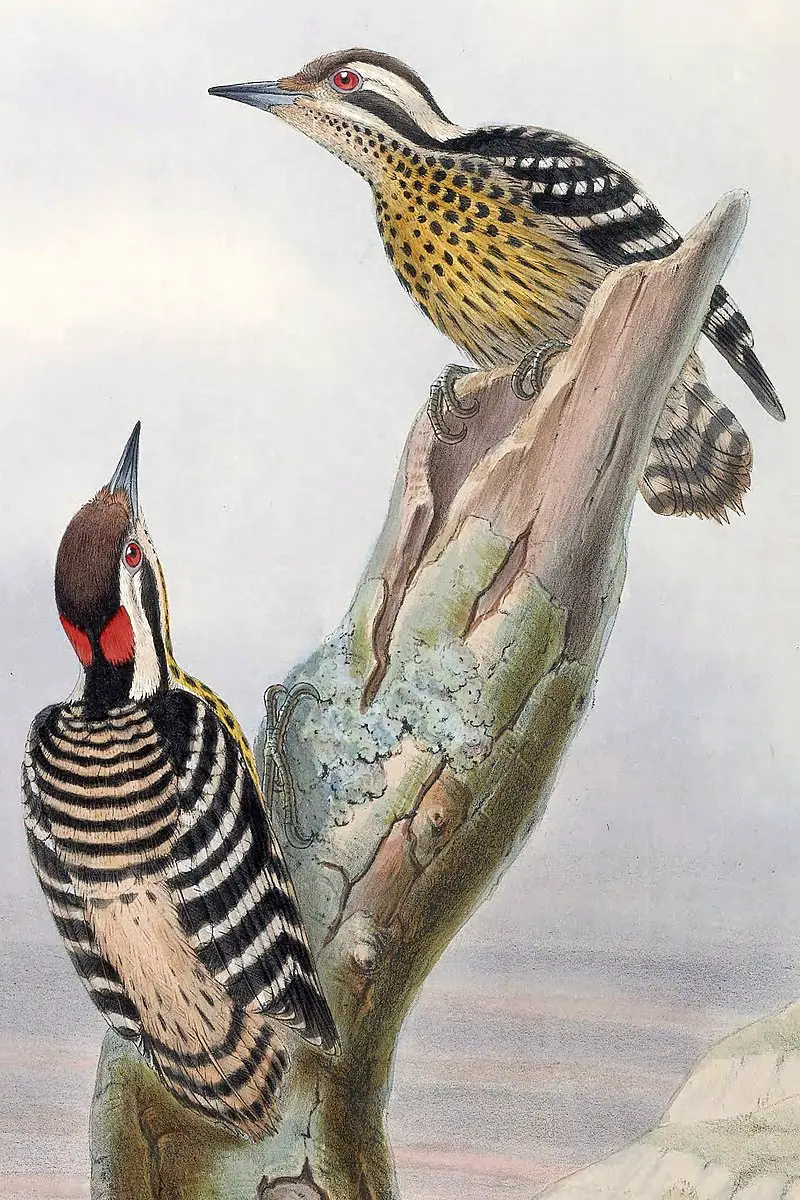
The Philippine pygmy woodpecker is a small species of bird in the Picidae family. It has three different subspecies, validirostris, maculatus and menagei.
These birds have blackish-brown feathers on their back that are moderately barred with white stripes, as well as a white throat which features a dark spot.
In Kapampangan they are called Anluage. They can be seen living in forests and woodlands mostly around the Philippines but also parts of Indonesia and Malaysia where there is suitable habitat for them to survive; such habitats include mangroves and coastal areas.
The Philippine pygmy woodpecker does not migrate due to its size so it remains within its area even during winter times when food sources become scarce or difficult to find because of snowfall or lack thereof.Scientific classification:
| Kingdom | Animalia |
| Phylum | Chordata |
| Class | Aves |
| Order | Piciformes |
| Family | Picidae |
| Genus | Yungipicus |
| Species | Y. maculatus |
7. Philippine Hanging Parrot
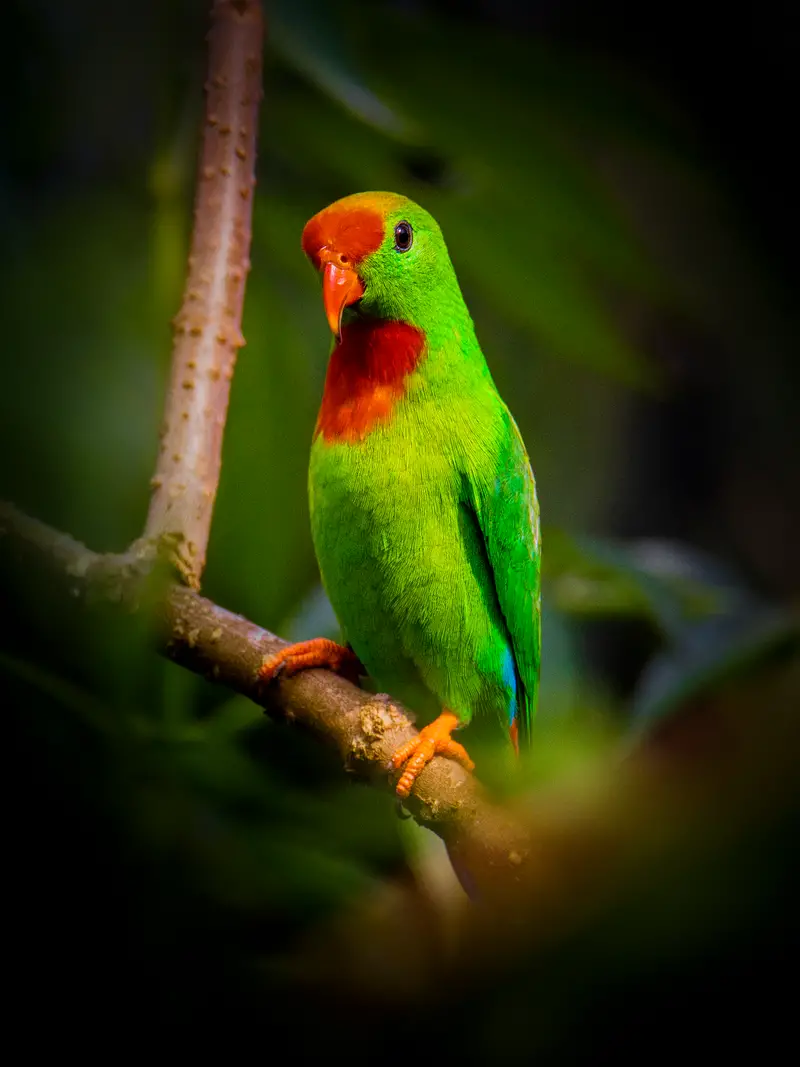
The Philippine Hanging Parrot is a small, psittaculid parrot species found in the Philippines. It has 11 subspecies, one of which may be distinct from the others.
The bird is known by its local Tagalog name ‘Kulasisi’. This beautiful bird can usually be seen hanging upside down on thin branches or vines and feeds mainly on fruits and flowers.
Despite being listed as Least Concern by IUCN, some of its subspecies are under threat due to deforestation and illegal trapping for pet trade.
Conservation efforts must therefore be taken to ensure their survival in the wild.Scientific classification:
| Kingdom | Animalia |
| Phylum | Chordata |
| Class | Aves |
| Order | Psittaciformes |
| Family | Psittaculidae |
| Genus | Loriculus |
| Species | L. philippensis |
8. Plain Bush-Hen
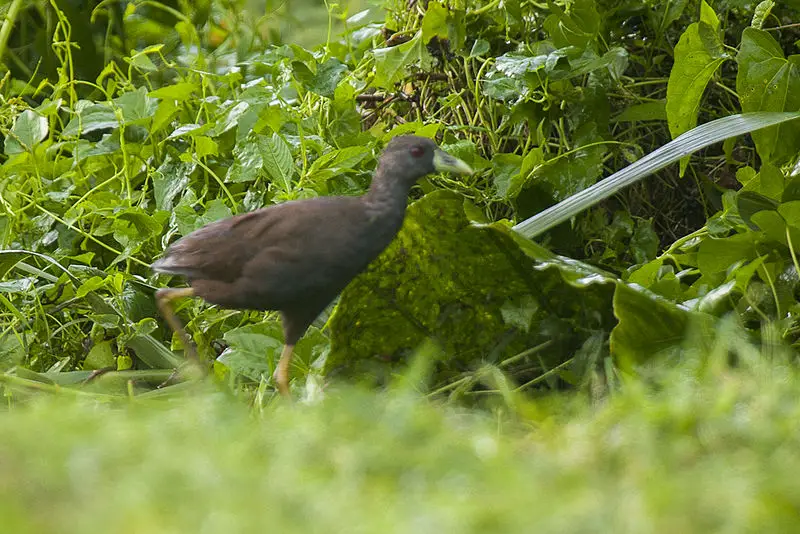
The Plain bush-hen is a species of bird in the Rallidae family, found only in The Philippines. It has an olive-brown color with pale yellow underparts and black barring on its wings, tail and head.
Its bill is short and thick while legs are long for wading through shallow water to find food like small invertebrates, seeds or fruits.
They usually stay close to bodies of water such as swamps or marshes where they can hide from predators by standing very still among tall grasses or vegetation when danger approaches.
During breeding season males attract females with loud calls repeated several times throughout the day which help them pair up easily but nest sites remain hidden since these birds build their nests low on ground next to dense bushes providing excellent camouflage against potential threats.Scientific classification:
| Kingdom | Animalia |
| Phylum | Chordata |
| Class | Aves |
| Order | Gruiformes |
| Family | Rallidae |
| Genus | Amaurornis |
| Species | A. olivacea |
9. Spotted Wood Kingfisher
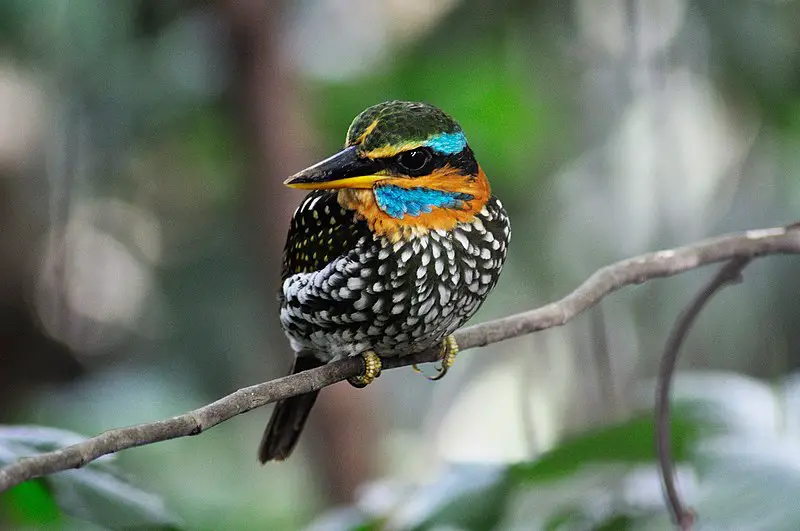
The Spotted wood kingfisher is an eye-catching bird native to the Philippines. It has a vibrant plumage of blue, black and white with distinctive spots on its wings and tail feathers.
This species stands out from other Philippine kingfishers due to its size; it measures around 10 inches in length.
The Spotted wood kingfisher lives mainly in subtropical or tropical moist lowland forests where they feed on fish, frogs and insects among others.
These birds are usually found near lakes, rivers or streams as they need water sources for hunting prey items which require diving into the water surface often times doing so multiple times per day.
Conservation efforts have been put forth by various organizations as this species population is threatened by deforestation caused by humans activities such as urbanization, logging etcScientific classification:
| Kingdom | Animalia |
| Phylum | Chordata |
| Class | Aves |
| Order | Coraciiformes |
| Family | Alcedinidae |
| Subfamily | Halcyoninae |
| Genus | Actenoides |
| Species | A. lindsayi |
10. Negros Bleeding-Heart Pigeon
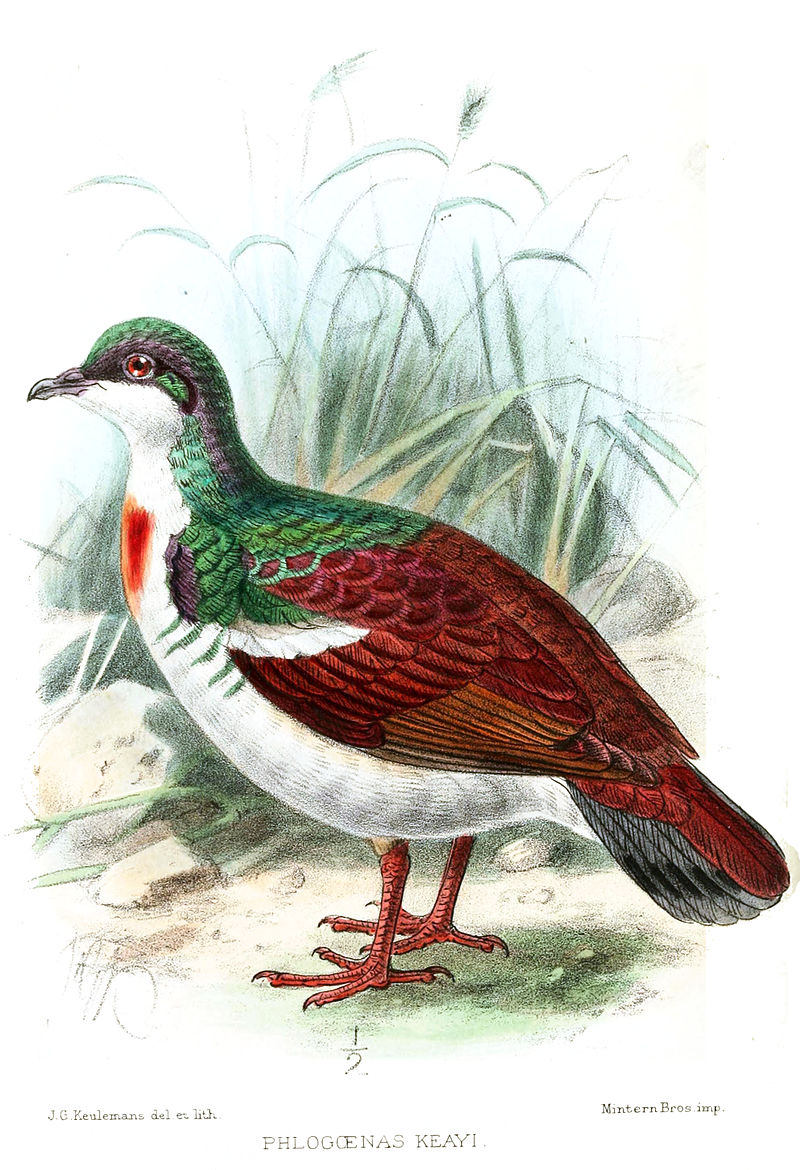
The Negros bleeding-heart pigeon is an endangered bird endemic to the Philippines. This species has a small population of only 50 – 249 mature individuals and its habitat on the islands of Negros and Panay continues to decline due to ongoing forest loss.
It is characterized by its reddish chest which gives it its name, in addition to having brown feathers with white spots scattered throughout their bodies.
The birds are known for being shy and elusive as well as living in dense forests where they feed on fruit, seeds, buds, flowers, snails and other insects found there.
Conservation efforts should be taken seriously if this unique species is going to survive into future generations.Scientific classification:
| Kingdom | Animalia |
| Phylum | Chordata |
| Class | Aves |
| Order | Columbiformes |
| Family | Columbidae |
| Genus | Gallicolumba |
| Species | G. keayi |
11. Black-Chinned Fruit Dove
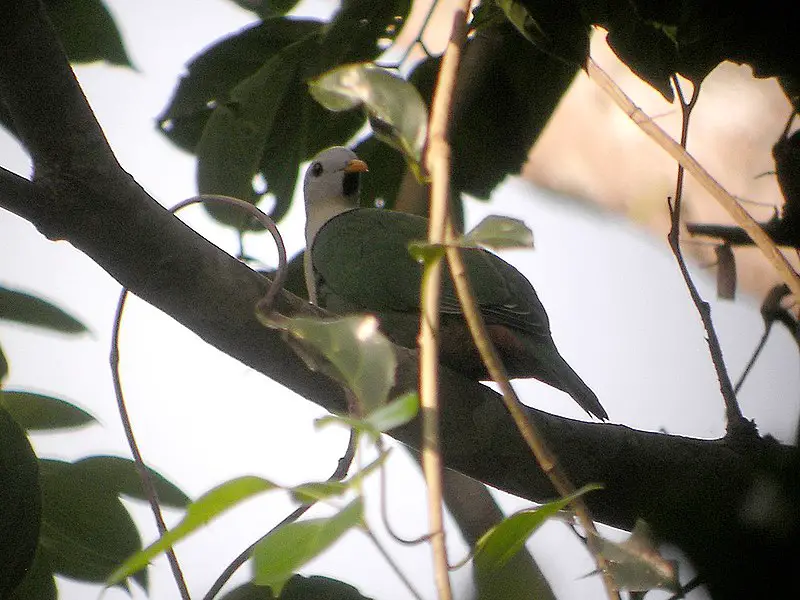
The Black-chinned Fruit Dove is a stunningly beautiful bird with its vibrant colors and unique features.
Males have green bellies, wings, and tails; whitish grey heads and necks with purple bases; red irises; yellow bills with small black patches underneath.
Females have green heads, necks, backs of the head to the tail feathers which are dark brown in color.
This species can grow up to 27 cm long making it medium sized for a dove species. They inhabit lowland forests from northern India throughout Southeast Asia as far north as Taiwan where they feed on fruits like figs along with some insects too.
These birds usually travel alone or in pairs during their migrations but flocks may also form when food sources become available at certain times of year.Scientific classification:
| Kingdom | Animalia |
| Phylum | Chordata |
| Class | Aves |
| Order | Columbiformes |
| Family | Columbidae |
| Genus | Ptilinopus |
| Species | P. leclancheri |
Also Featured In: Most Common Birds of Lubang Island,
12. Hooded Pitta
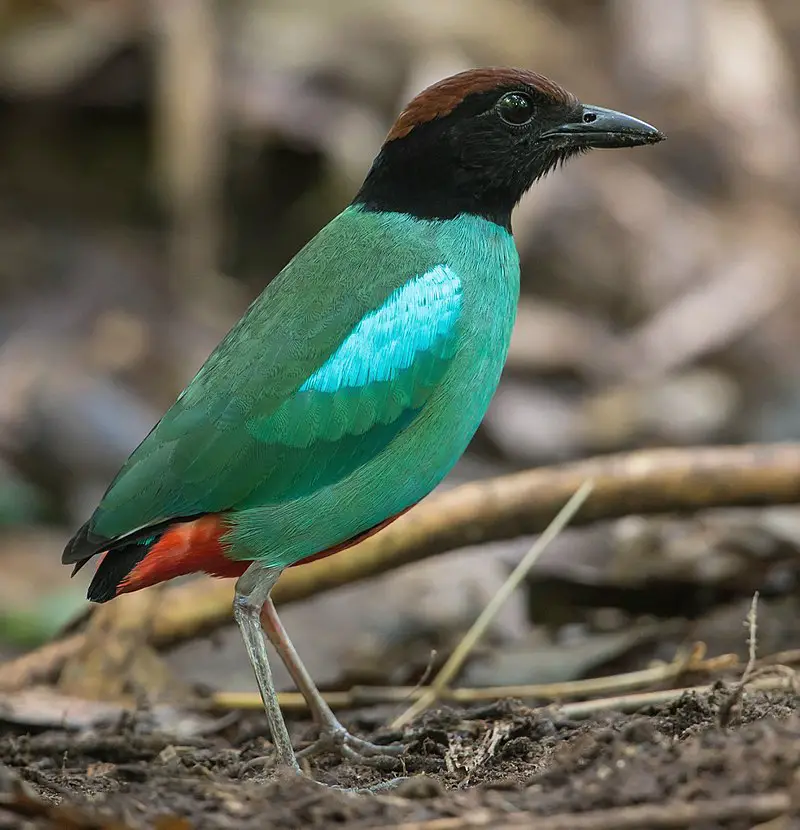
The Hooded Pitta is a beautiful and vibrant bird found in eastern and southeastern Asia, as well as maritime Southeast Asia. This small passerine has bright green feathers with a black head crowned by chestnut-colored plumage.
It feeds mainly on insects and their larvae but can also be seen eating berries from time to time.
During breeding season it inhabits forests of various types such as plantations or cultivated areas; these birds build ground nests usually near water sources so they can stay hydrated throughout the day.
The Hooded Pitta makes for an interesting sight to see out in nature.Scientific classification:
| Kingdom | Animalia |
| Phylum | Chordata |
| Class | Aves |
| Order | Passeriformes |
| Family | Pittidae |
| Genus | Pitta |
| Species | P. sordida |
Also Featured In: Beautiful Malaysian birds,
13. Tawny Grassbird
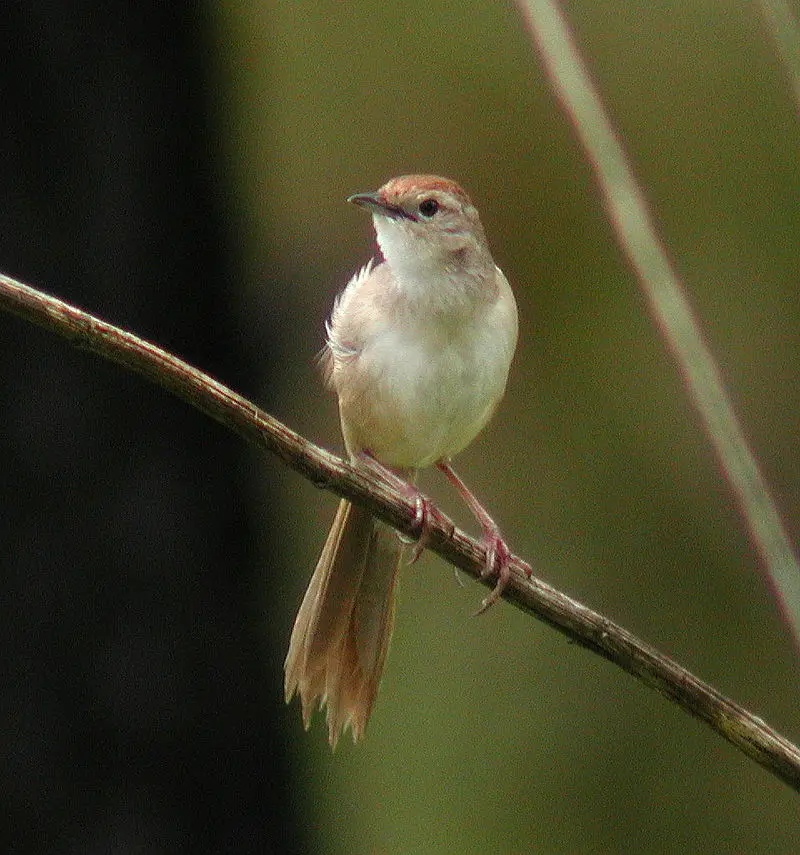
The tawny grassbird is a large songbird with an impressive brown cap and streaked upperparts. This bird belongs to the family of Locustellidae which live in grassland or reedbed habitats.
Its under parts are paler, while it has a long graduated tail. It also makes loud grumpy churring calls and longer ticking call that starts tick-tick-tick-tic.
They prefer open areas like wet meadows, marshlands or wetlands for their habitat as they feed on small insects from these area such as spiders, ants and beetles among others.
Their diet consist mainly of insects but some may supplement them with vegetable matter too during winter months when insect availability is low .
The tawny grassbirds usually breed between August to October each year depending upon the weather conditions..Scientific classification:
| Kingdom | Animalia |
| Phylum | Chordata |
| Class | Aves |
| Order | Passeriformes |
| Family | Locustellidae |
| Genus | Cincloramphus |
| Species | C. timoriensis |
Also Featured In: Timor-Leste birds,
14. Bar-Bellied Cuckooshrike
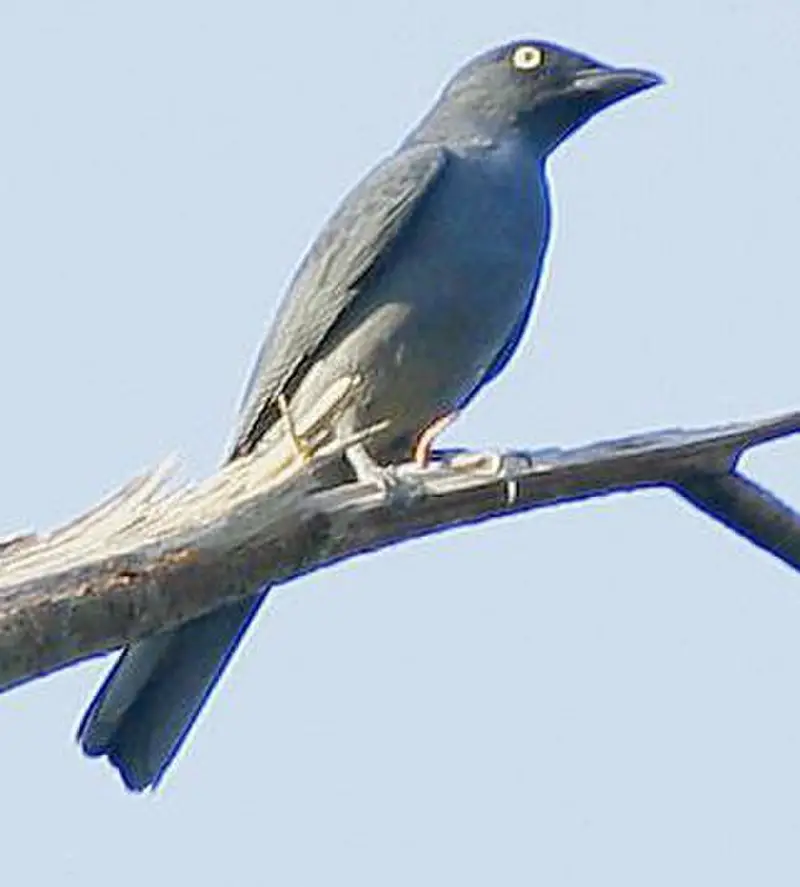
The Bar-bellied cuckooshrike is a species of bird belonging to the Campephagidae family. It can be found in Thailand, Malaysia, Indonesia and the Philippines inhabiting mangrove forests, dry forest, swamp forest and secondary growth areas.
Its plumage varies depending on its subspecies with different amounts of barring present on their underparts.
The International Union for Conservation of Nature (IUCN) has classified it as Least Concern due to its wide distribution range but there are still threats from habitat destruction that could affect populations over time.
This colourful bird makes an interesting addition to any enthusiast’s list.Scientific classification:
| Kingdom | Animalia |
| Phylum | Chordata |
| Class | Aves |
| Order | Passeriformes |
| Family | Campephagidae |
| Genus | Coracina |
| Species | C. striata |
Also Featured In: Brunei Darussalam Birds,
15. Indigo-Banded Kingfisher
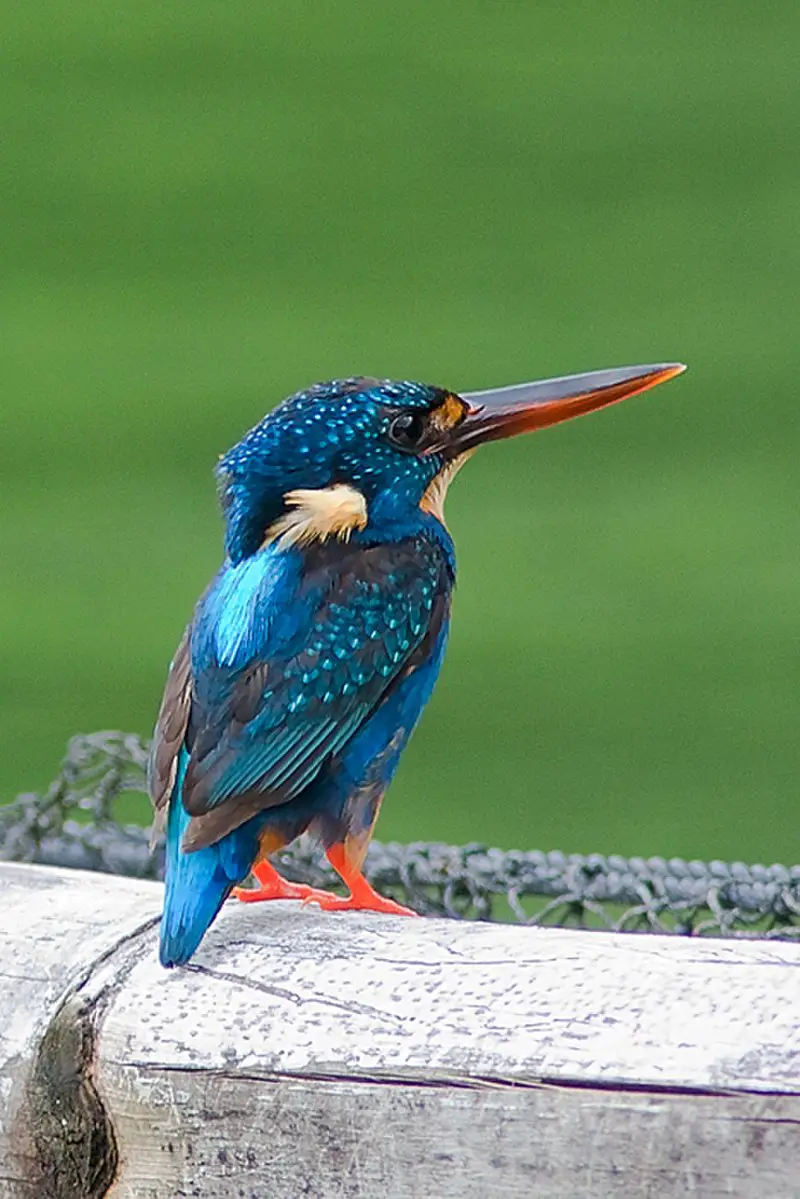
The Indigo-banded kingfisher is a species of bird belonging to the Alcedinidae family, found only in the Philippines. It has two subspecies – C. c. cyanopectus and C.
c nigriostris – which are generally uncommon but locally widespread across northern and central islands such as Luzon, Polillo, Mindoro, Sibuyan and Ticao; Panay; Negros respectively.
This vibrant yet small bird has striking plumage – predominantly blue with white patches on its wings along with an iridescent purple lower back that extends up to its head forming a crown like appearance giving it an air of regalness.
In terms of behavior they tend to be solitary birds preying mainly upon insects or small fish near rivers or ponds while perching atop branches close by allowing them ample opportunities for their characteristic dive bombing technique when hunting prey.Scientific classification:
| Kingdom | Animalia |
| Phylum | Chordata |
| Class | Aves |
| Order | Coraciiformes |
| Family | Alcedinidae |
| Subfamily | Alcedininae |
| Genus | Ceyx |
| Species | C. cyanopectus |
Also Featured In: Kingfishers Species, Common Philippines Birds
16. Negros Fruit Dove
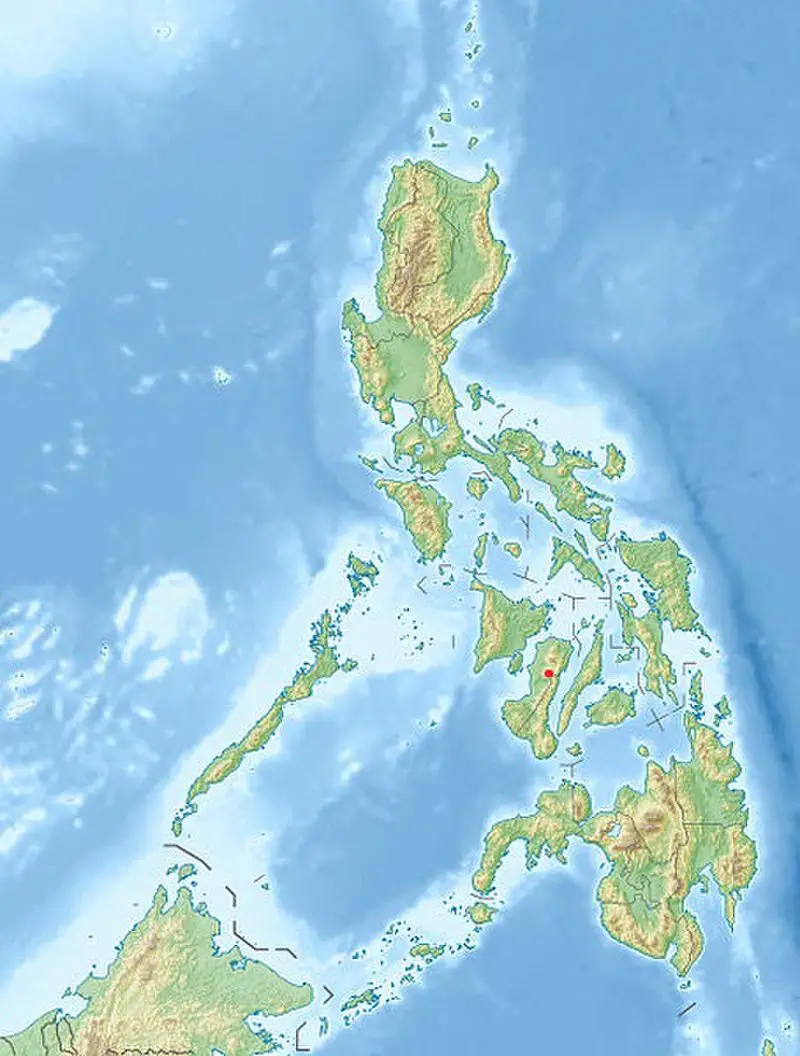
The Negros Fruit Dove is an endangered species of bird native to the island of Negros in the Philippines.
It was first discovered when a single female specimen was found on Mount Kanlaon, located in the northern part of the island.
Its overall plumage is bright yellow and green with reddish-brown wings and tail feathers. The dove feeds mainly on fruits such as papaya and banana, although it may also eat insects or other small animals occasionally.
Unfortunately, its population has been heavily impacted by logging activities that have caused much destruction to its habitat thus leading to a significant decline in numbers over time.
Conservation measures need to be taken soon if this beautiful species is going to survive into future generations.Scientific classification:
| Kingdom | Animalia |
| Phylum | Chordata |
| Class | Aves |
| Order | Columbiformes |
| Family | Columbidae |
| Genus | Ptilinopus |
| Species | P. arcanus |
Also Featured In: Pigeons Species,
17. Philippine Cuckoo-Dove
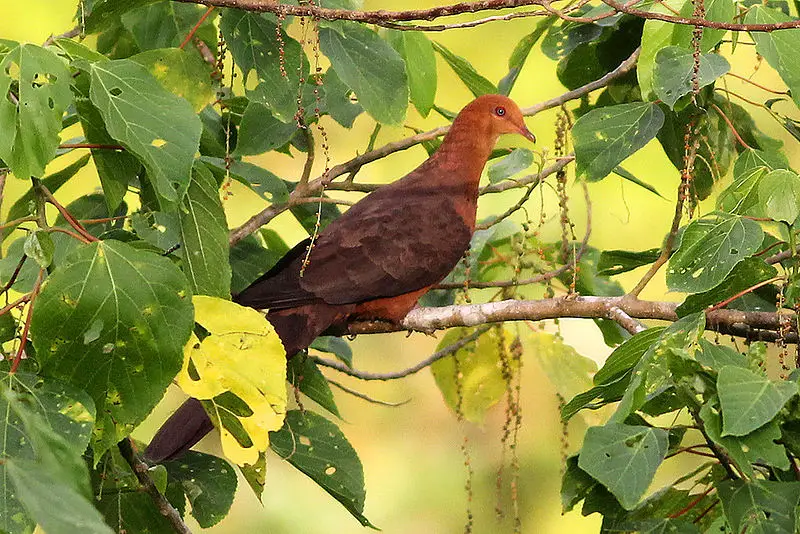
The Philippine cuckoo-dove is a species of bird found in the Philippines and Taiwan. It was first described by French zoologist Charles Lucien Jules Laurent Bonaparte in 1854, and is currently listed as a least concern species on the International Union for Conservation of Nature Red List of Endangered Species.
This dove typically has brownish grey plumage with white spots, long tail feathers, and black eyespots on its wings which it uses to startle predators away from nests or young birds.
Its diet consists mainly of fruits such as figs and berries along with some insects that are caught while perched low down amongst trees or bushes.
The Philippine cuckoo-dove tends to form pairs during breeding season but otherwise lives alone or within small groups outside this period.Scientific classification:
| Kingdom | Animalia |
| Phylum | Chordata |
| Class | Aves |
| Order | Columbiformes |
| Family | Columbidae |
| Genus | Macropygia |
| Species | M. tenuirostris |
Also Featured In: Mindoro Birds You Should Know, Beautiful Birds Found in Coron Island
18. Philippine Swiftlet
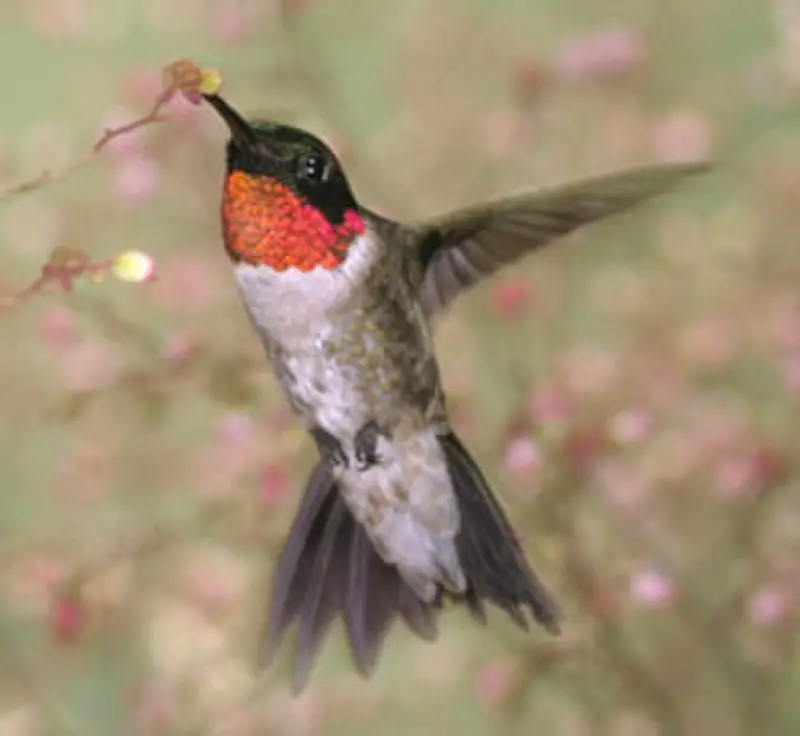
The Philippine swiftlet is a species of bird belonging to the Apodidae family found only in the Philippines. It inhabits dry and moist lowland forests as well as montane forests, making it quite adaptable.
The coloration of this small-medium sized bird ranges from greyish brown to black with white markings on its wings and tail feathers.
Its diet consists mainly of insects which are caught while flying through the air or picked up off trees or branches.
This species has been classified by IUCN Red List as least concern due to its wide distribution range across multiple islands within the country, although some local populations may be at risk if deforestation continues unchecked in their habitats.Scientific classification:
| Kingdom | Animalia |
| Phylum | Chordata |
| Class | Aves |
| Order | Apodiformes |
| Family | Apodidae |
| Genus | Aerodramus |
| Species | A. mearnsi |
Also Featured In: Swifts Species, Palawan Island Birds
19. Elegant Tit
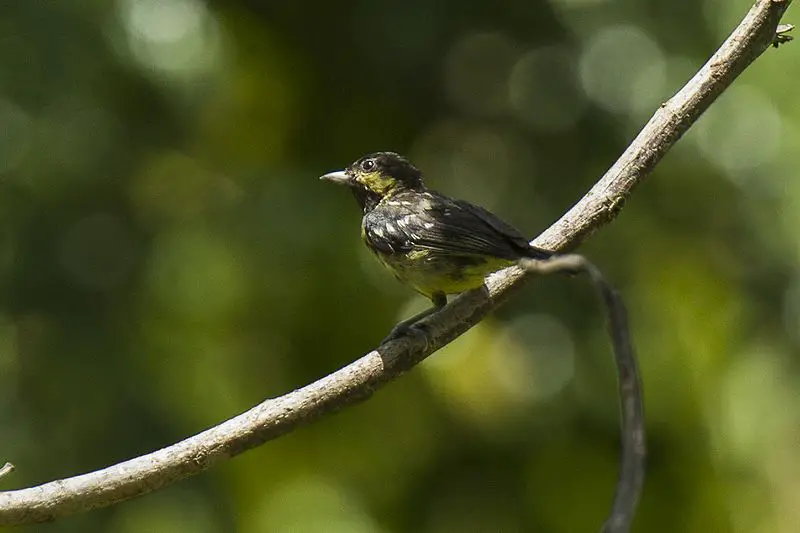
The Elegant tit bird is a beautiful species of tit that is found exclusively in the Philippines. Formerly classified under the Parus genus, it was subsequently reclassified under Pardaliparus along with the yellow-bellied tit and Palawan tit.
This change was based on the findings of a molecular study in 2013 that led to the resurrection of several genera.
The Elegant tit is known for its elegant features and is highly sought after by bird enthusiasts. This bird is a testament to the rich wildlife found in the Philippines and is a welcomed addition to the avian kingdom.
Overall, the Elegant tit bird is a unique and beautiful species that deserves admiration and protection.Scientific classification:
| Kingdom | Animalia |
| Phylum | Chordata |
| Class | Aves |
| Order | Passeriformes |
| Family | Paridae |
| Genus | Pardaliparus |
| Species | P. elegans |
Also Featured In: Mindanao Birds You Should Know,
20. Whiskered Treeswift
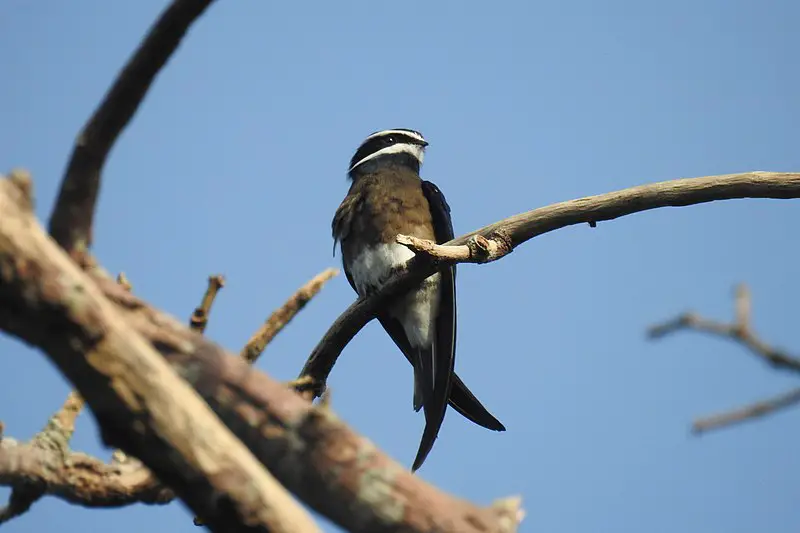
The Whiskered treeswift is a small bird belonging to the Hemiprocnidae family. It is one of the four species in the Hemiprocne genus, and it can be found in Brunei, Indonesia, Malaysia, Myanmar, the Philippines, Singapore, and Thailand.
This species inhabits subtropical or tropical moist lowland forest, mangrove forest, and moist montane forests.
The bird’s whiskers give it an interesting look, hence its name. Though small, the Whiskered treeswift is an adept aerial hunter, darting through the trees in search of insects.
Its small size also allows it to fly quickly and maneuver easily in tight spaces. This bird is considered to be of least concern when it comes to conservation status, as its population is thought to be stable.Scientific classification:
| Kingdom | Animalia |
| Phylum | Chordata |
| Class | Aves |
| Clade | Strisores |
| Order | Apodiformes |
| Family | Hemiprocnidae |
| Genus | Hemiprocne |
| Species | H. comata |
Also Featured In: Birds that Live in Borneo Island, Birds that Live in Kuala Lumpur
21. Striated Swallow
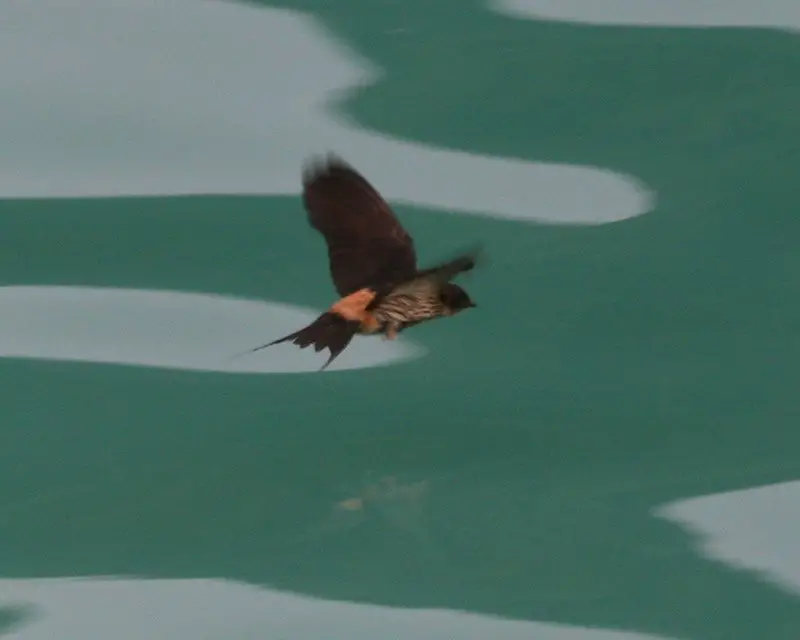
The Striated swallow bird is commonly found in Southeast Asia, Taiwan, and northeastern India. It prefers open areas with clearings and cultivation, especially hilly regions.
It has blue upperparts and a deeply forked tail, measuring 19 cm in length. A reddish collar distinguishes it from other similar species. Formerly, it was considered a subspecies of the Red-rumped swallow.
These agile birds are often seen darting through the air, catching insects on the wing. Their diet mainly consists of flying insects, which they catch using their beaks.
Often found in small flocks, they build nests made of mud pellets, usually under the eaves of buildings or other man-made structures.
These birds are an important part of the ecosystem, helping to control insect populations and serving as important pollinators.Scientific classification:
| Kingdom | Animalia |
| Phylum | Chordata |
| Class | Aves |
| Order | Passeriformes |
| Family | Hirundinidae |
| Genus | Cecropis |
| Species | C. striolata |
Also Featured In: Birds that Commonly Found in Bali, Common Birds of Lombok
22. Little Bronze Cuckoo
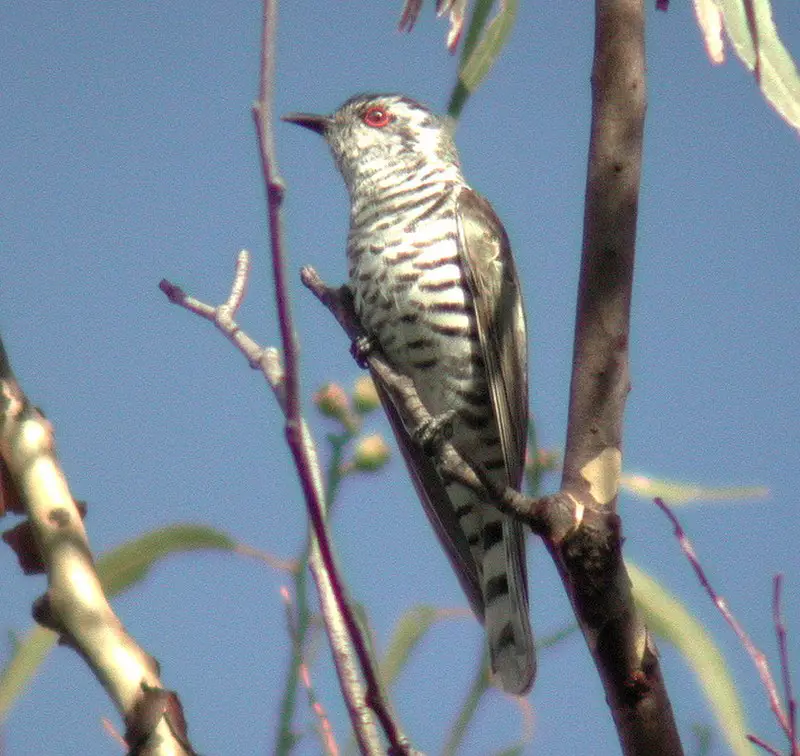
The Little Bronze Cuckoo, a member of the Cuculidae family, can be found in Southeast Asia, New Guinea, and northern and eastern Australia, in subtropical or tropical moist lowland forests.
As the world’s smallest cuckoo bird, it only weighs around 17 grams and measures 15 cm in length. It is distinct from other cuckoos with its bronze-green body, white undertail, and long tail with a white tip.
The male bird is known for its unique call “pia-pia-pia,” which it uses to attract a mate during breeding season.
Little Bronze Cuckoo subspecies rufomerus and crassirostris are often considered separate species due to their distinct physical characteristics.
The Little Bronze Cuckoo is an interesting bird to observe in the wild with its small size and beautiful coloring.Scientific classification:
| Kingdom | Animalia |
| Phylum | Chordata |
| Class | Aves |
| Order | Cuculiformes |
| Family | Cuculidae |
| Genus | Chrysococcyx |
| Species | C. minutillus |
Also Featured In: HDB Approved by Birds, Common Townsville Birds
23. Visayan Hornbill
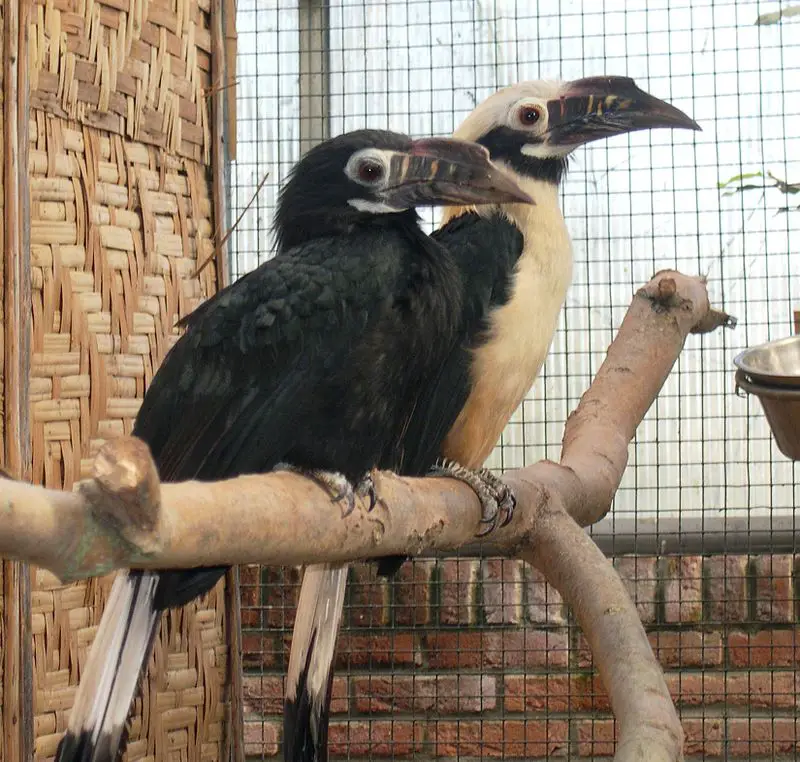
The Visayan hornbill, endemic to several Philippine islands, is a magnificent bird found in the dense rainforests of Panay, Negros, Masbate, and Guimaras.
Initially considered as part of the tarictic hornbill species, it is now recognized as a standalone bird with a distinct appearance and behavior.
The Visayan hornbill boasts a unique beak that defines its beauty and functions as a significant tool in hunting and feeding.
Unfortunately, its population faces threats due to habitat loss and hunting, putting it at risk of extinction.
Conservation efforts have been made to protect this valuable bird, including the establishment of protected areas and widespread awareness programs.
Future steps require a collective effort to sustain the existence of the Visayan hornbill and ensure that future generations can enjoy its beauty.Scientific classification:
| Kingdom | Animalia |
| Phylum | Chordata |
| Class | Aves |
| Order | Bucerotiformes |
| Family | Bucerotidae |
| Genus | Penelopides |
| Species | P. panini |
24. White-Throated Jungle-Flycatcher
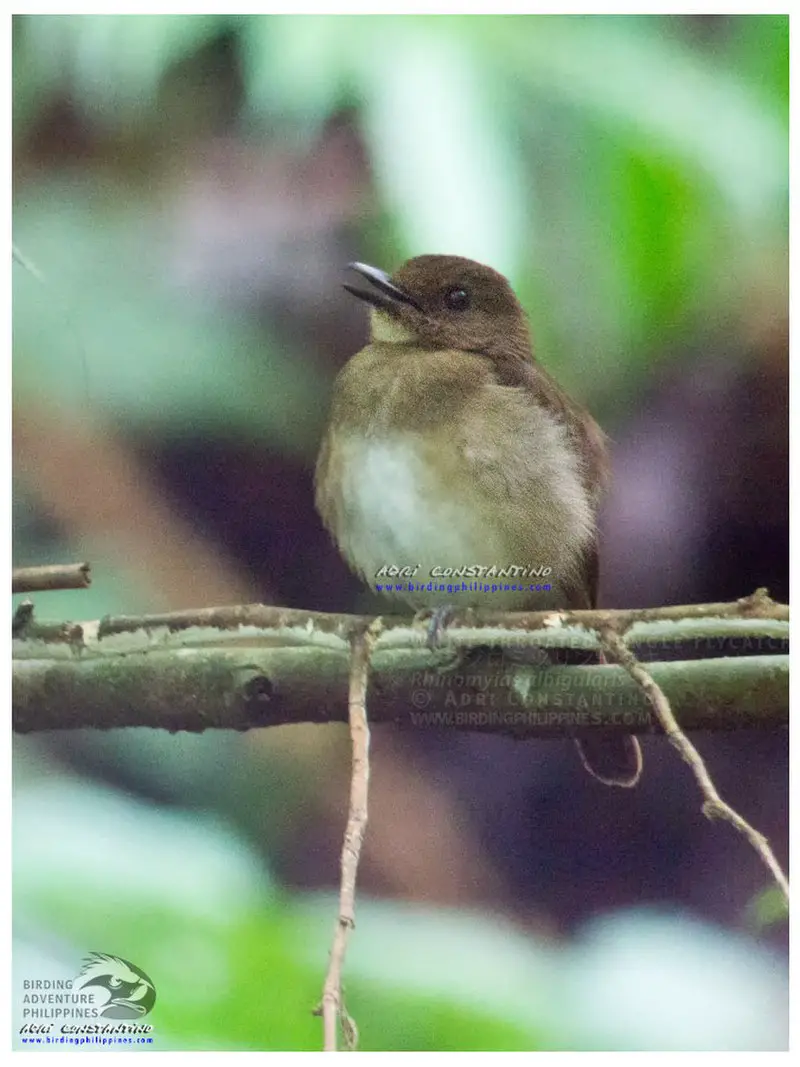
The White-throated Jungle-flycatcher, also known as Negros jungle flycatcher is a bird species of the Old World flycatcher family.
This bird is found in the tropical moist lowland forests of the Philippines, specifically in the Negros and Panay islands.
Sadly, the species has been extirpated or made locally extinct on Guimaras. These birds have a distinctive white-throat which differentiates them from other flycatchers.
They are known to catch insects in mid-air, gliding gracefully through the forest, and can be easily recognized by their sharp and melodious chirps.
The White-throated Jungle-flycatcher’s natural habitat is under threat due to deforestation and other human activities.
Therefore, it is essential to conserve this species and ensure that their habitat is safeguarded.Scientific classification:
| Kingdom | Animalia |
| Phylum | Chordata |
| Class | Aves |
| Order | Passeriformes |
| Family | Muscicapidae |
| Genus | Vauriella |
| Species | V. albigularis |
25. Fire-Breasted Flowerpecker
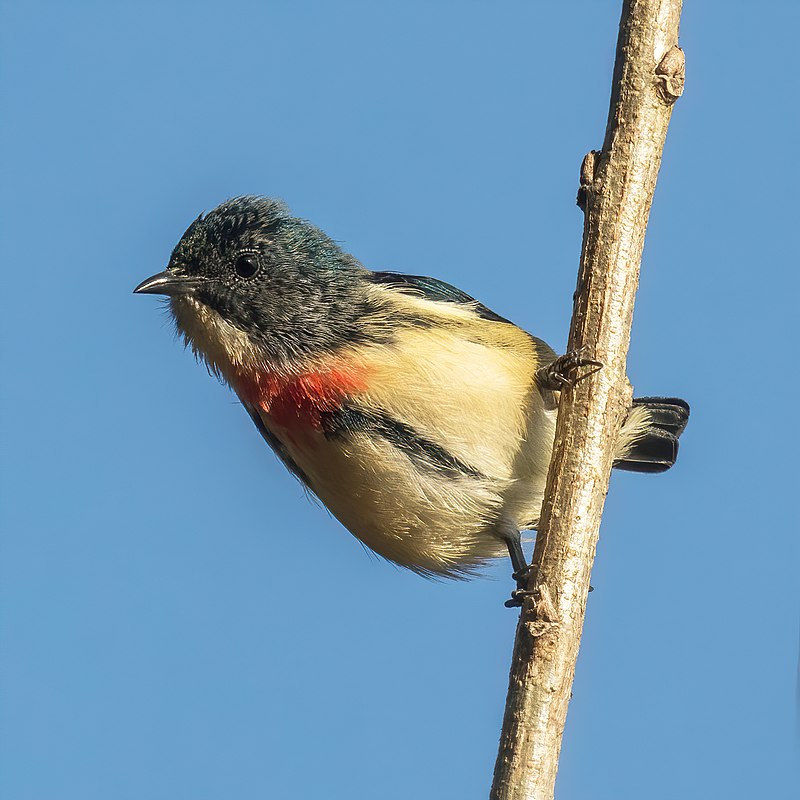
The Fire-breasted flowerpecker is a small bird found in the Indian Subcontinent and Southeast Asia. It is a member of the Dicaeidae family and is known for feeding on fruits and helping to disperse fruiting plants.
Unlike many other flowerpeckers, this species has a striking sexual dimorphism. The male bird has contrasting upper plumage while the female has a more subdued appearance.
Because of its beauty, the Fire-breasted flowerpecker is a popular bird among birdwatchers and nature enthusiasts.
Its crucial role in the ecosystem makes it an important species to protect and conserve. Overall, the Fire-breasted flowerpecker is a fascinating bird that is both aesthetically pleasing and ecologically significant.Scientific classification:
| Kingdom | Animalia |
| Phylum | Chordata |
| Class | Aves |
| Order | Passeriformes |
| Family | Dicaeidae |
| Genus | Dicaeum |
| Species | D. ignipectus |
Also Featured In: Common Birds of Hainan,
26. Turquoise Flycatcher
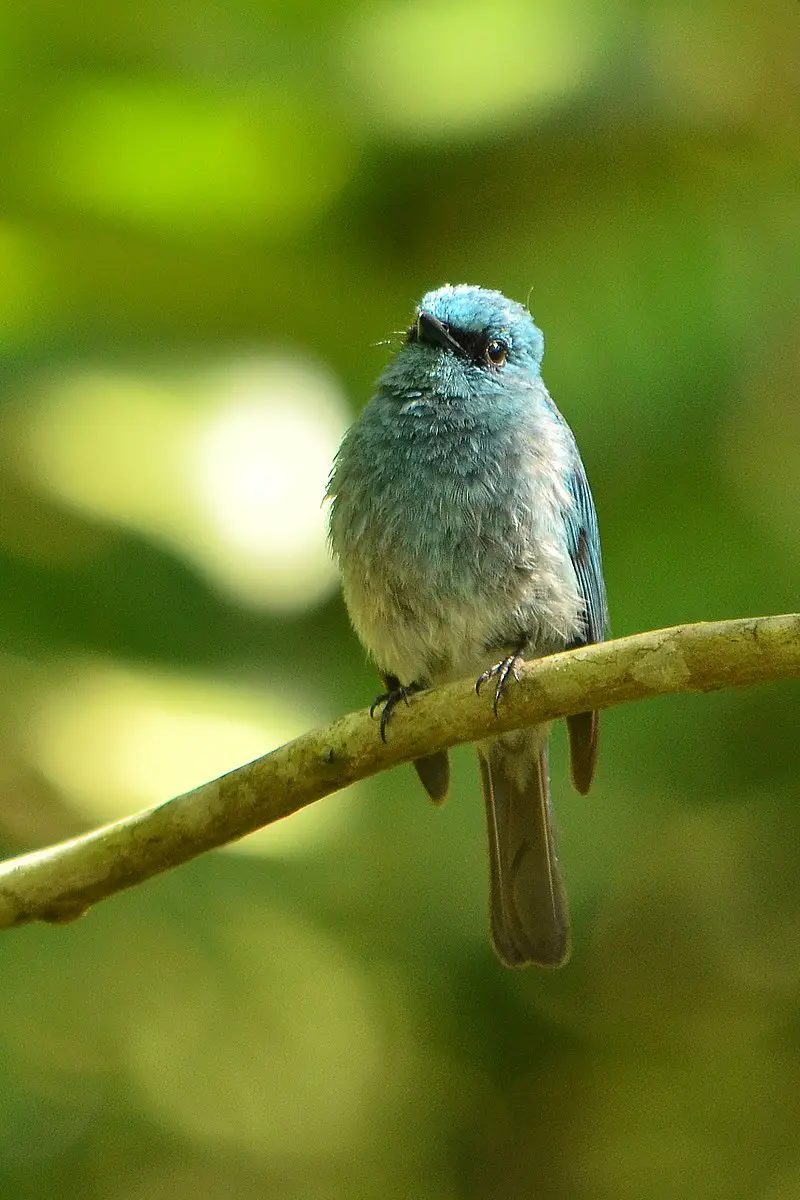
The turquoise flycatcher bird is a member of the Muscicapidae family. It can be found in the lush, subtropical forests of Indonesia and the Philippines.
Aptly named for its beautiful turquoise color, this small bird is also known as the island flycatcher. It thrives in moist, montane forests and flits through the trees in search of insects for food.
Despite its small size, it has a loud and clear whistle-like call that echoes through the forest. This stunning bird is a testament to the beauty and diversity of the natural world.Scientific classification:
| Kingdom | Animalia |
| Phylum | Chordata |
| Class | Aves |
| Order | Passeriformes |
| Family | Muscicapidae |
| Genus | Eumyias |
| Species | E. panayensis |
Also Featured In: Birds that Live Near Halmahera,
27. Black-Belted Flowerpecker
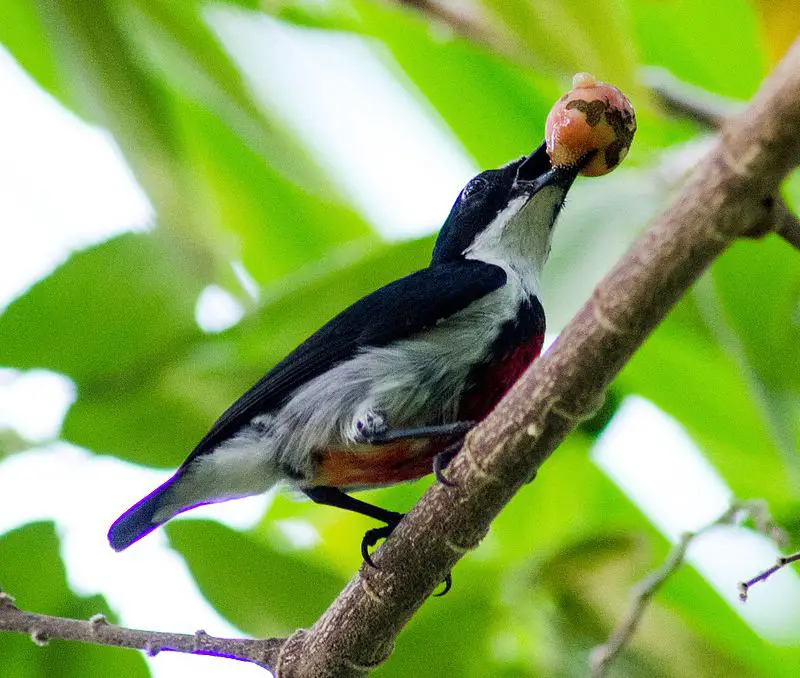
The Black-belted flowerpecker, also known as the Visayan flowerpecker, is a bird species found only in the Philippines. It inhabits Panay, Negros, and Guimaras islands.
This bird belongs to the Dicaeidae family and was once considered a subspecies of the red-keeled flowerpecker. Its name comes from the distinct black band that encircles the bird’s white belly.
The Black-belted flowerpecker feeds on nectar, insects, and fruits. It has a small and compact body, making it easy to maneuver through dense foliage. The male bird has a bright red throat, while the female’s throat is yellow.
The population of the Black-belted flowerpecker is threatened by habitat loss and degradation due to deforestation, agriculture, and human development. Conserving this bird species and its forest habitats is crucial for its survival.Scientific classification:
| Kingdom | Animalia |
| Phylum | Chordata |
| Class | Aves |
| Order | Passeriformes |
| Family | Dicaeidae |
| Genus | Dicaeum |
| Species | D. haematostictum |
28. Magnificent Sunbird
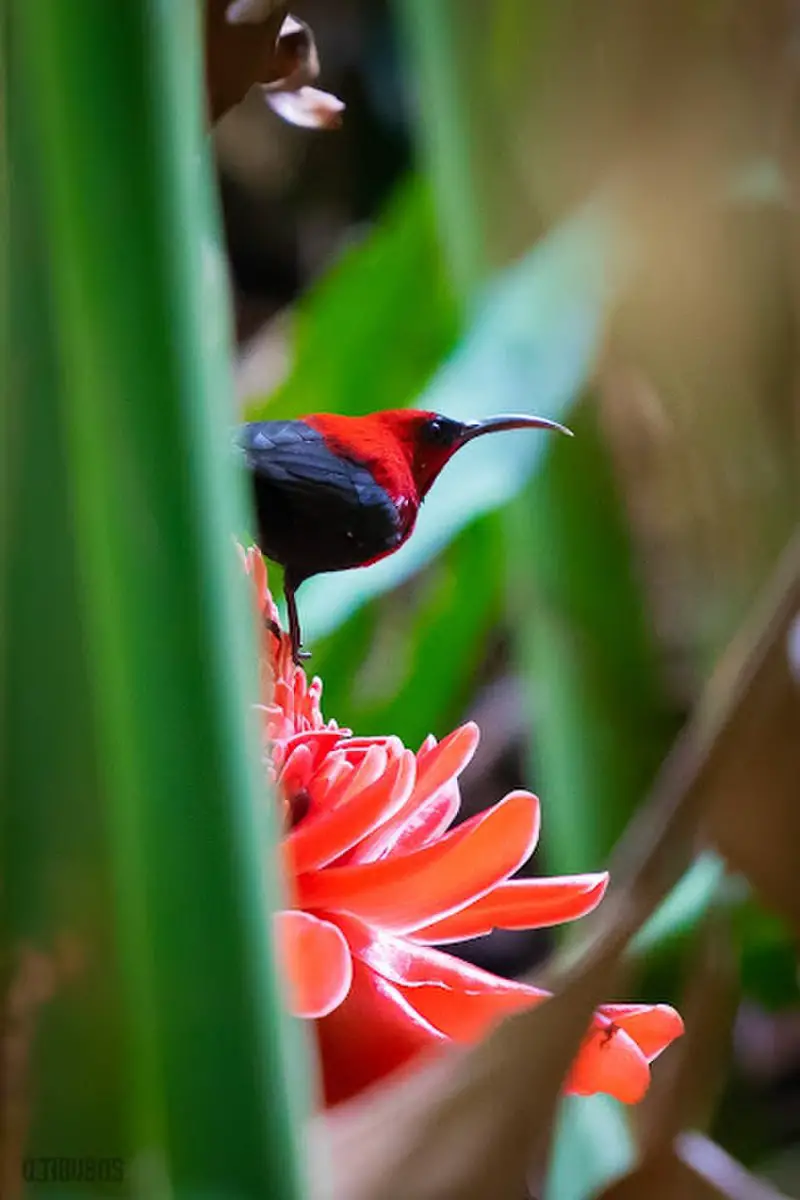
The Magnificent sunbird is a beautiful bird in the sunbird family, known for its ability to feed on nectar and insects. These birds have short wings which allow them to fly fast and direct in their search for food.
While they can hover like hummingbirds to extract nectar, they usually prefer perching while feeding. This species is endemic to the western Philippines and can typically be found in the Visa region.
Its bright colors and unique feeding habits make it a fascinating bird to study and admire in the wild.Scientific classification:
| Kingdom | Animalia |
| Phylum | Chordata |
| Class | Aves |
| Order | Passeriformes |
| Family | Nectariniidae |
| Genus | Aethopyga |
| Species | A. magnifica |
29. Pink-Bellied Imperial Pigeon
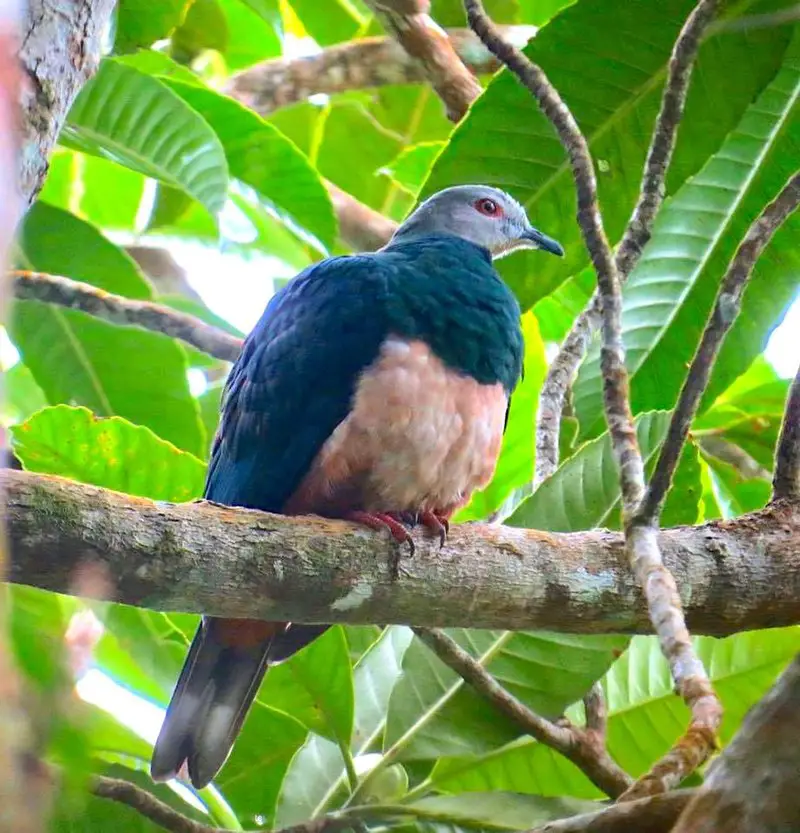
The Pink-bellied imperial pigeon, also called the zone-tailed pigeon, is a large bird found in the Philippines that can grow up to 42cm long. They are mostly dark green in color, with a gray head and a pink belly.
Their tail has a brown, black, and gray pattern, and their eyes and eye ceres are both red. The Pink-bellied imperial pigeon has a diet consisting mostly of fruit.
These birds are known for their stunning appearance and large size, making them an impressive sight in the wild.
They are a unique addition to the bird species of the Philippines, and their distinctive features make them stand out amongst other birds in the area.
Despite their size, Pink-bellied imperial pigeons are peaceful birds and pose no threat to humans or other animals.Scientific classification:
| Kingdom | Animalia |
| Phylum | Chordata |
| Class | Aves |
| Order | Columbiformes |
| Family | Columbidae |
| Genus | Ducula |
| Species | D. poliocephala |
Also Featured In: Samar Island Birds You Should Know,
30. Visayan Fantail
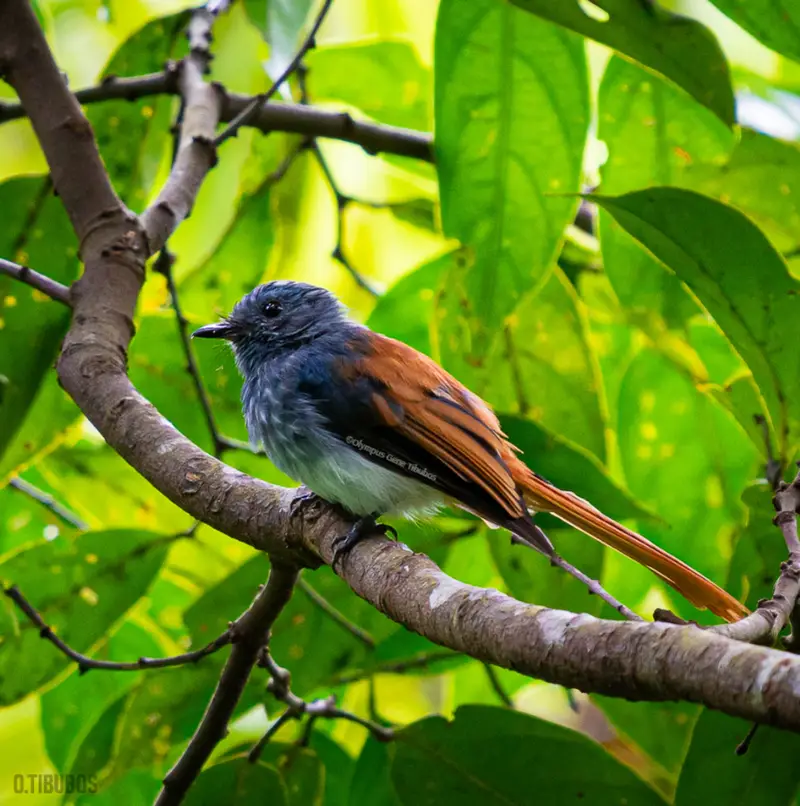
The Visayan fantail bird is native to the Philippines and can be found on various islands including Negros, Panay, Guimaras, Masbate, and Ticao. This medium-sized bird has a long tail and is often found in forested areas.
Its head, chest, back, and shoulder are a dull blue color with some paler blue streaking on its underparts.
This bird was previously considered to be the same species as the blue-headed fantail and Tablas fantail. However, it is now recognized as a distinct species.
As an endemic species to the Philippines, the Visayan fantail bird serves as an important part of the country’s biodiversity and is a sight to behold for birdwatching enthusiasts.Scientific classification:
| Kingdom | Animalia |
| Phylum | Chordata |
| Class | Aves |
| Order | Passeriformes |
| Family | Rhipiduridae |
| Genus | Rhipidura |
| Species | R. albiventris |
31. Purple-Throated Sunbird
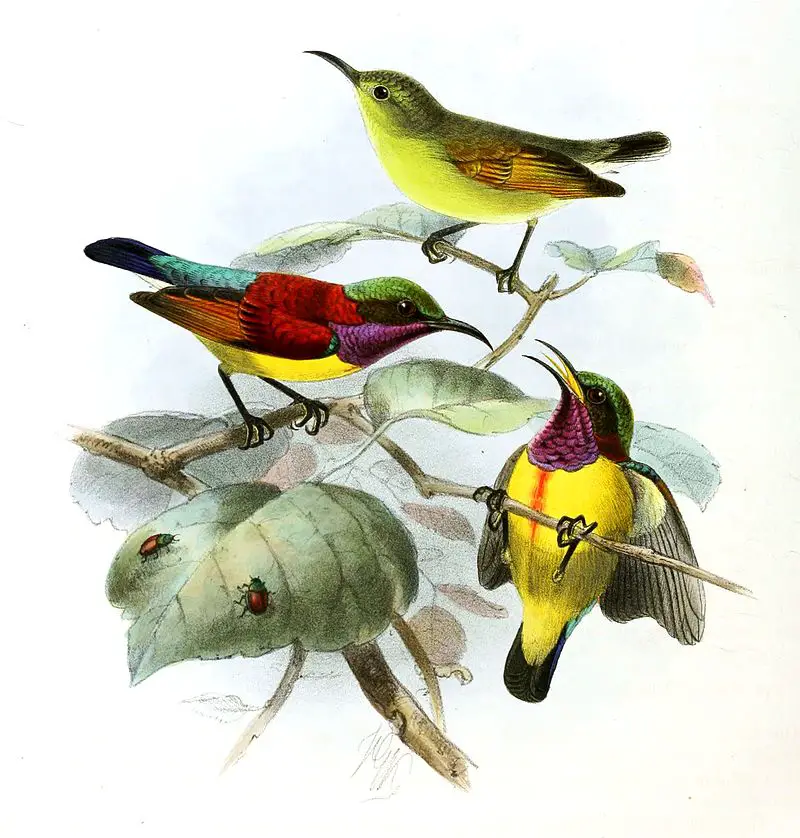
The purple-throated sunbird is a bird species that belongs to the Nectariniidae family. It can be found in lowland tropical forests and subtropical or tropical mangrove forests of Maratua and the Philippines.
This small bird has a purple-colored throat that distinguishes it from other sunbirds. It was first described by French zoologist Mathurin Jacques Brisson in 1760.
The Van Hasselt’s sunbird used to be considered the same species as the purple-throated sunbird, but they are now recognized as distinct species.
These birds feed mainly on nectar, and they play an essential role in pollination. The purple-throated sunbird is a fascinating bird that attracts attention with its brightly colored throat and its important ecological role.Scientific classification:
| Kingdom | Animalia |
| Phylum | Chordata |
| Class | Aves |
| Order | Passeriformes |
| Family | Nectariniidae |
| Genus | Leptocoma |
| Species | L. sperata |
32. Green-Faced Parrotfinch
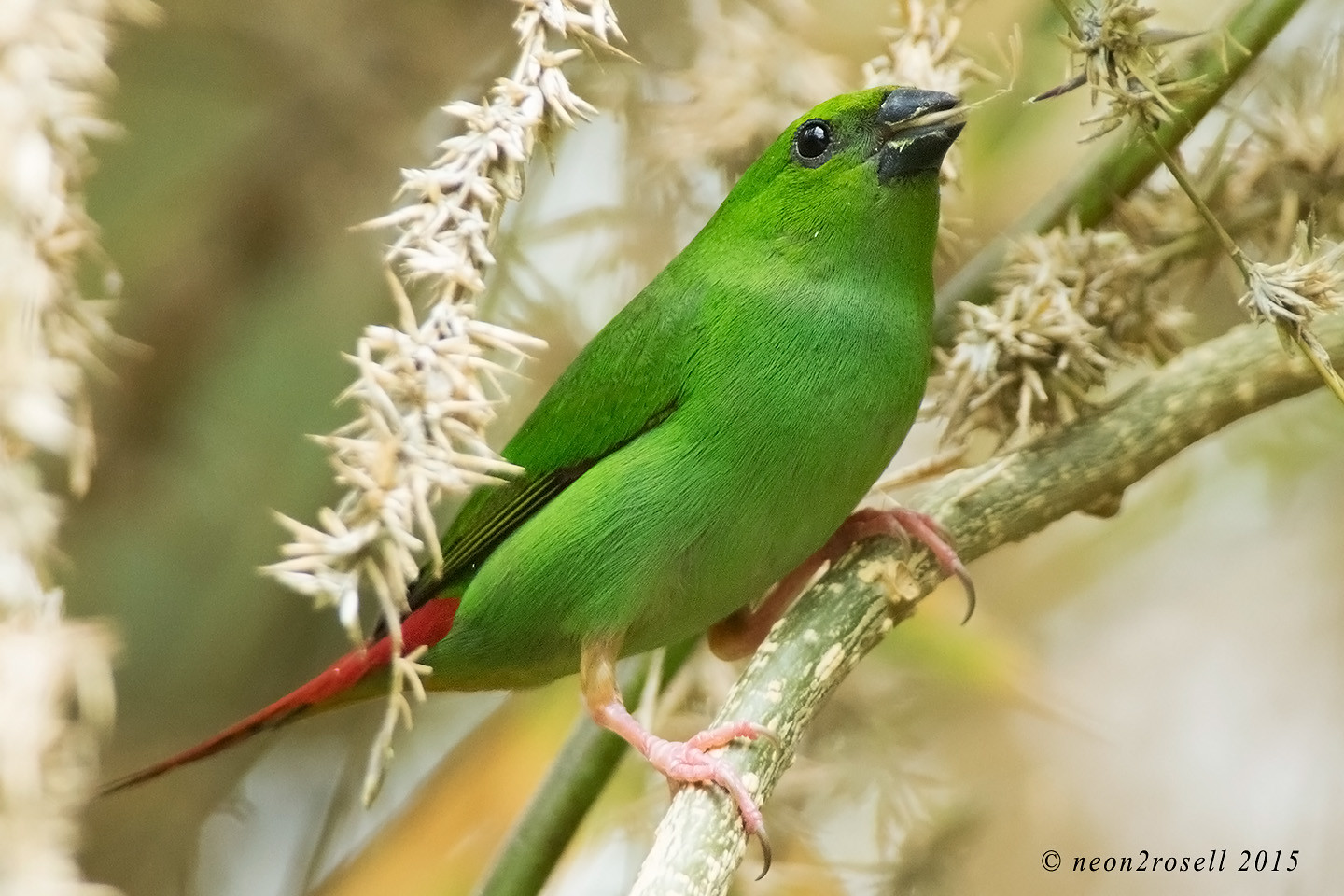
The Green-faced parrotfinch is a small bird found in the northern Philippines, specifically on Luzon, Mindoro, Panay, Negros, and Cebu islands. It is locally known as mayang-kawayan in Tagalog.
Measuring only 12-13 cm long, this bird is known for its green plumage, bright red uppertail-coverts, and tail, and darker fringes on its primaries.
As its name suggests, the Green-faced parrotfinch belongs to the parrotfinch family and is a colorful addition to the birdlife of the region.
Its appearance and small size make it a delightful sight for birdwatchers and enthusiasts alike, showcasing the diversity of nature in the Philippines.
While not much is known about the behavior of this bird, the Green-faced parrotfinch is an important bird for local conservation efforts.Scientific classification:
| Kingdom | Animalia |
| Phylum | Chordata |
| Class | Aves |
| Order | Passeriformes |
| Family | Estrildidae |
| Genus | Erythrura |
| Species | E. viridifacies |
33. Philippine Nightjar
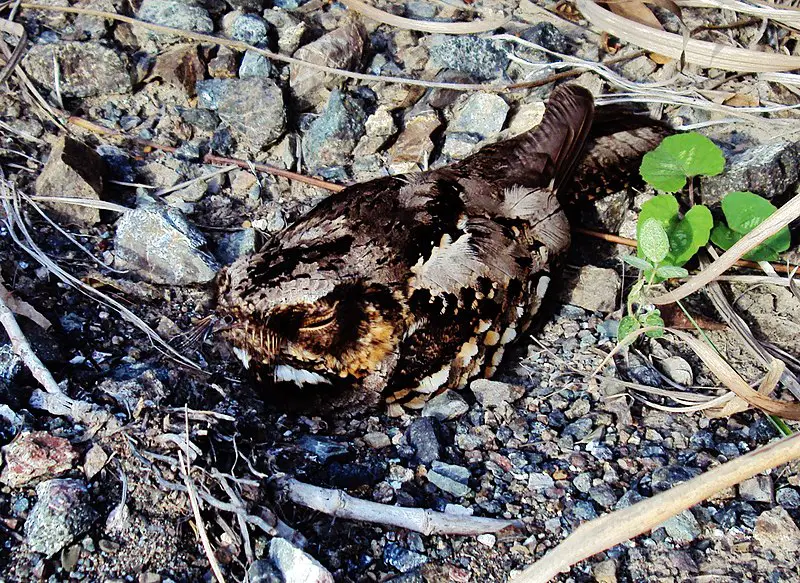
The Philippine Nightjar is a unique species of bird that can only be found in the Philippines. It is locally known as kandarapa and tagolilong.
This bird belongs to the Caprimulgidae family and commonly resides in subtropical or tropical forests with moist lowlands or mangroves.
Occasionally, it can also dwell in the subtropical or tropical forests in mountainous areas. The Philippine Nightjar is a nocturnal bird and is active only during nighttime.
They are small, with over-sized heads and wide beaks, perfectly crafted for catching insects in the air.
Though they are widely distributed throughout the country, they are elusive and incredibly difficult to spot, making them quite rare to witness.
Despite their rarity, the Philippine Nightjar continues to thrive in its natural habitat, making for a lovely sight to see for those who are fortunate enough to see them.Scientific classification:
| Kingdom | Animalia |
| Phylum | Chordata |
| Class | Aves |
| Clade | Strisores |
| Order | Caprimulgiformes |
| Family | Caprimulgidae |
| Genus | Caprimulgus |
| Species | C. manillensis |
34. White-Vented Whistler
The White-vented whistler is a bird belonging to the Pachycephalidae family. It inhabits the forests of southern Philippines and some Malaysian islands.
With its natural habitats being subtropical or tropical moist lowland and montane forests, this bird is a treat for bird watchers.
Also known as the White-bellied whistler, it must not be confused with another species of the same name.
These small birds are known for their sweet melodious whistles and can be easily recognized due to their white vent feathers. Rarely seen in captivity, these birds are mostly found in their natural habitats.
The White-vented whistler is a delight for both ornithologists and bird lovers, who admire its unique feather and sweet chirping.Scientific classification:
| Kingdom | Animalia |
| Phylum | Chordata |
| Class | Aves |
| Order | Passeriformes |
| Family | Pachycephalidae |
| Genus | Pachycephala |
| Species | P. homeyeri |
35. Philippine Spine-Tailed Swift
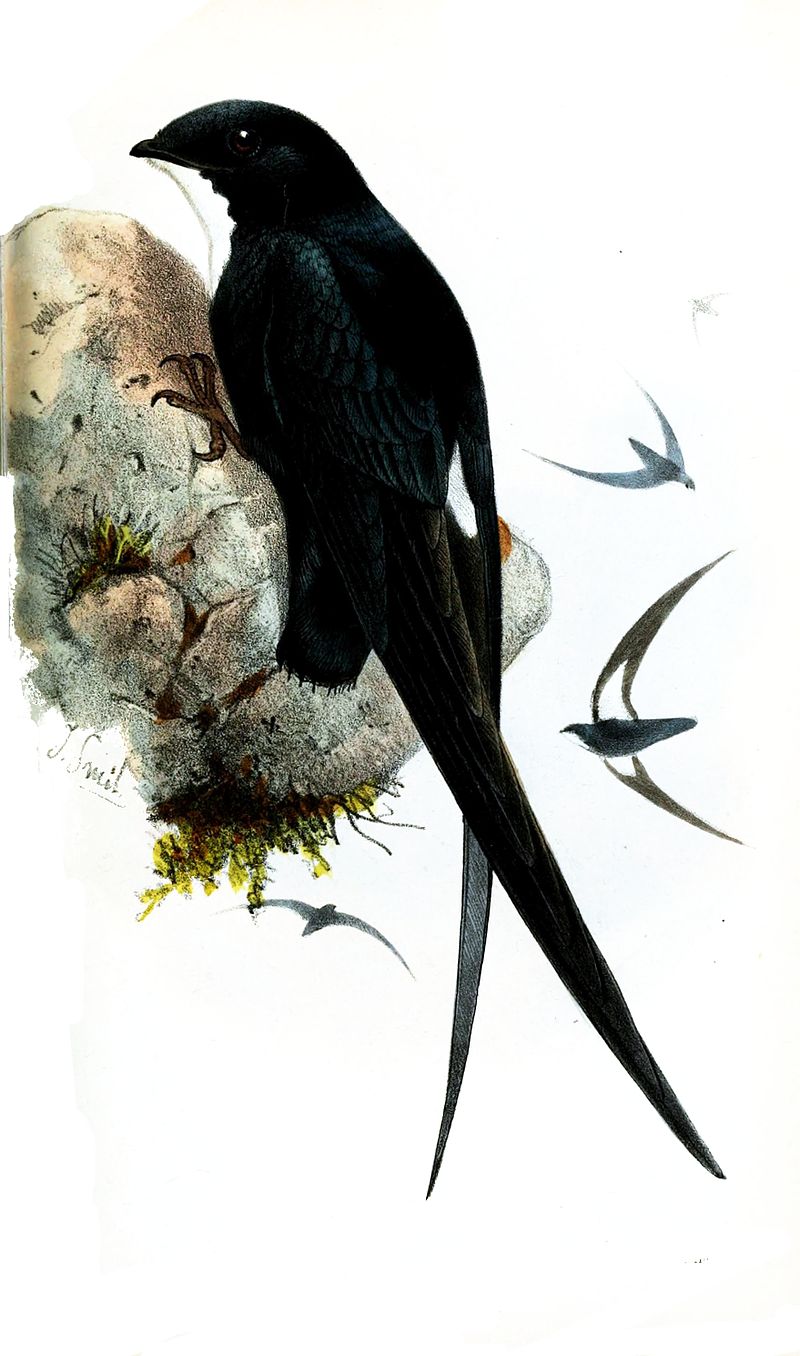
The Philippine spine-tailed swift is a swift species found only in the Philippines. This bird is known by several names, including the Philippine needletail and the Philippine spinetail.
It is a medium-sized bird that prefers to live in tropical moist lowland forests. Sadly, the species is slowly disappearing due to habitat loss.
Not much is known about this elusive bird, but it is important to preserve its natural habitat to ensure its survival.Scientific classification:
| Kingdom | Animalia |
| Phylum | Chordata |
| Class | Aves |
| Clade | Strisores |
| Order | Apodiformes |
| Family | Apodidae |
| Genus | Mearnsia |
| Species | M. picina |
36. Handsome Sunbird
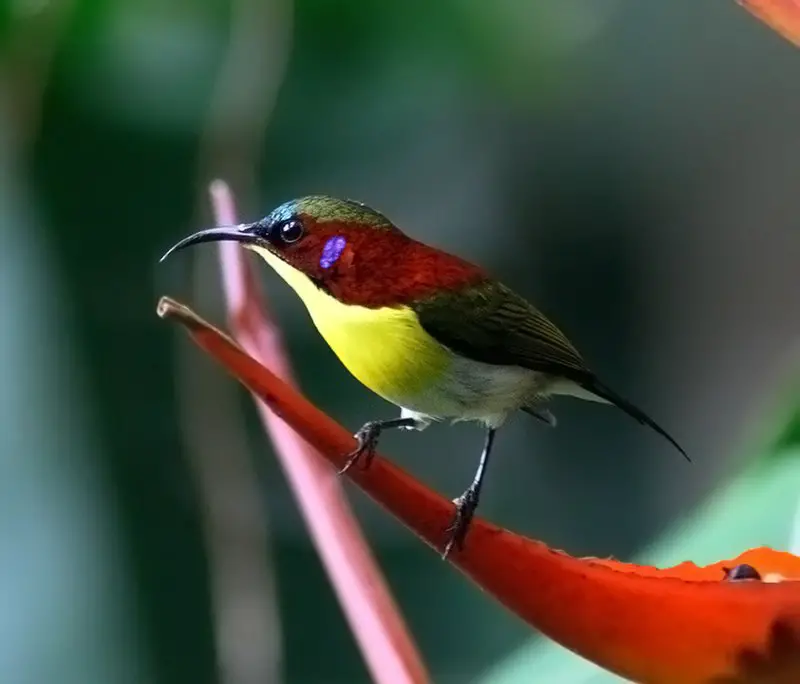
The Handsome sunbird, found exclusively in the Philippines, is a member of the Nectariniidae family. This species is known for its vibrant and striking colors, making it a visually stunning bird.
They are typically found in subtropical or tropical moist lowland forests and montane forests. Due to their affinity for nectar, they play an important role in pollination.
This bird species is known for its agility in flight and its elongated bill, perfectly designed for extracting nectar from flowers.
The Handsome sunbird is an important part of the ecosystem in which it resides, contributing to both biological diversity and the maintenance of plant life.
Its beauty can only be truly appreciated by those who have had the privilege of seeing it in person.Scientific classification:
| Kingdom | Animalia |
| Phylum | Chordata |
| Class | Aves |
| Order | Passeriformes |
| Family | Nectariniidae |
| Genus | Aethopyga |
| Species | A. bella |
37. Philippine Pitta
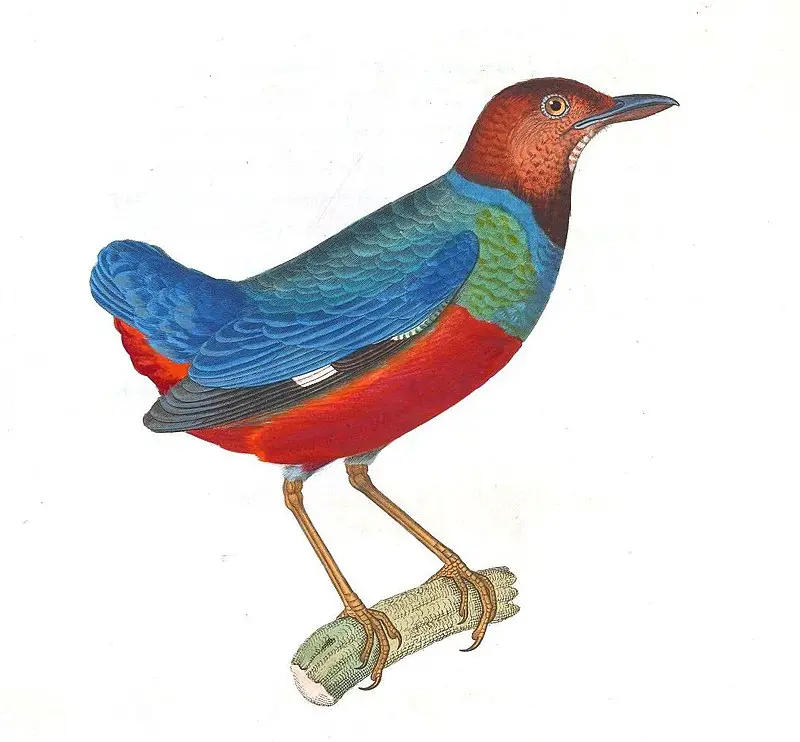
The Philippine pitta, also known as the blue-breasted pitta, is a bird found in the Philippines and Indonesia. With a pointed beak and a red belly, it has a distinct green-blue band above it.
The bird can be spotted in subtropical or tropical moist lowland forests, where it thrives in its natural habitat. This species was previously considered a subspecies of the red-bellied pitta, but was later recognized as a distinct species.
The Philippine pitta is a small bird with a wingspan that allows it to fly swiftly through dense forest foliage. It has a colorful plumage and adds to the natural beauty of the forests it inhabits.
Despite its beauty, this species faces threats to its habitat from deforestation and habitat fragmentation, which affect its population in the wild.Scientific classification:
| Kingdom | Animalia |
| Phylum | Chordata |
| Class | Aves |
| Order | Passeriformes |
| Family | Pittidae |
| Genus | Erythropitta |
| Species | E. erythrogaster |
38. Philippine Tailorbird
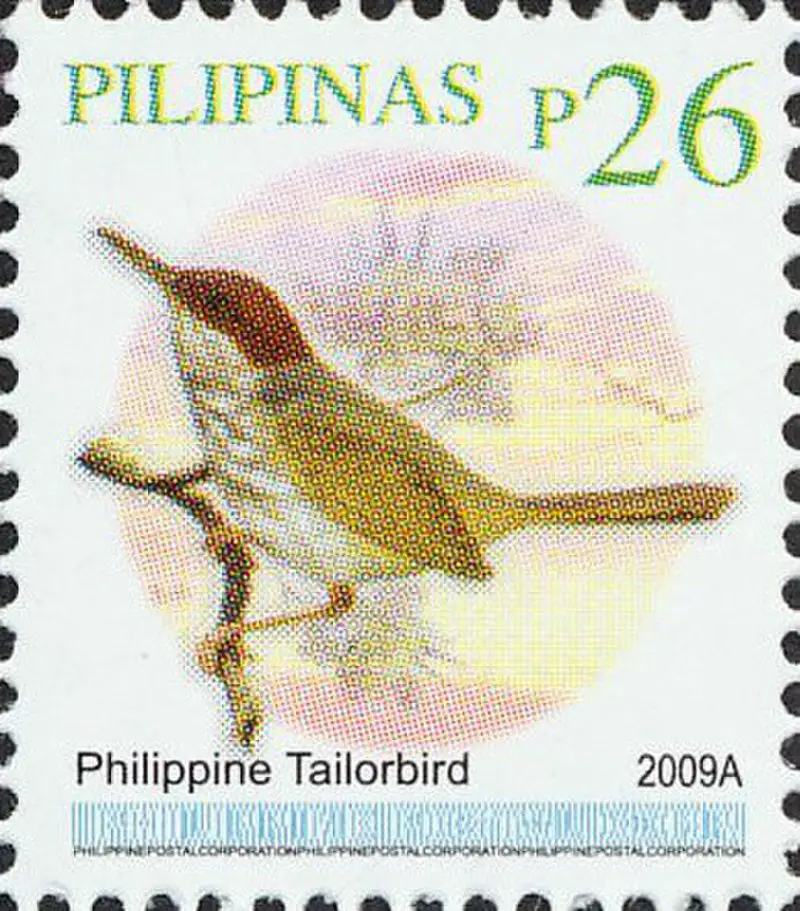
The Philippine tailorbird is a bird species that can be found in the western part of the Philippines. This bird species is classified in the family Cisticolidae, but it was originally grouped with the Old World warbler birds.
Its preferred habitats are the subtropical or tropical forests and mangroves that can be found in the region. As its name suggests, the Philippine tailorbird is known for its amazing sewing abilities to create its nests.
The bird uses spider webs and cobwebs to stitch together large leaves to create a suitable home for its eggs.
The Philippine tailorbird is a small bird with a mostly brown and white plumage. It is a relatively unknown species but is important for maintaining the biodiversity of the region.Scientific classification:
| Kingdom | Animalia |
| Phylum | Chordata |
| Class | Aves |
| Order | Passeriformes |
| Family | Cisticolidae |
| Genus | Orthotomus |
| Species | O. castaneiceps |
39. Ashy-Breasted Flycatcher
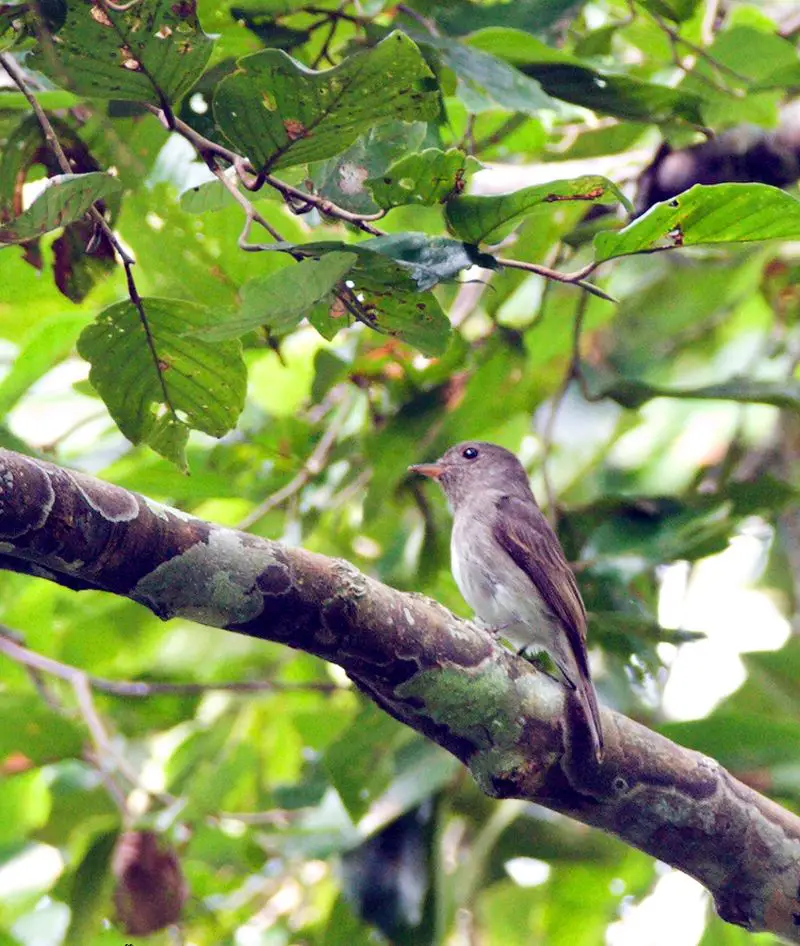
The Ashy-breasted flycatcher is a bird species found only in the Philippines, specifically on the islands of Negros and Luzon. They live in tropical moist lowland forests and are threatened by habitat loss.
These small and drab birds have gray-brown feathers with a darker wing color. Despite being little-known, they serve an important role in the ecosystem as insectivores.
The Ashy-breasted flycatcher is a reminder of the unique and diverse wildlife found in the Philippines that need protection and conservation efforts.Scientific classification:
| Kingdom | Animalia |
| Phylum | Chordata |
| Class | Aves |
| Order | Passeriformes |
| Family | Muscicapidae |
| Genus | Muscicapa |
| Species | M. randi |
40. Philippine Honey Buzzard
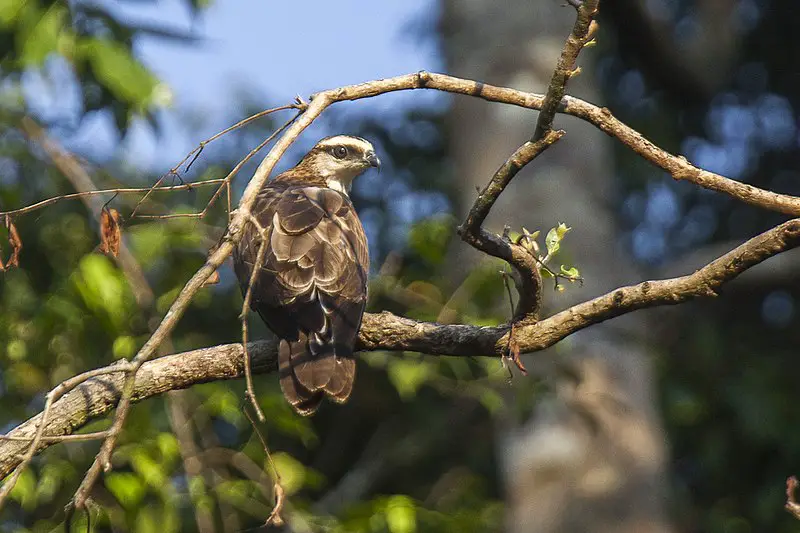
The Philippine honey buzzard, a member of the Accipitridae family, is a bird of prey that can be found in the lush forests of the Philippines. This species primarily resides in subtropical and tropical lowland and montane forests.
With its keen eyesight and sharp talons, it’s able to snatch prey while flying through the dense foliage. Its diet largely consists of bees and wasps, which it can digest without being affected by the toxins present in their bodies.
The Philippine honey buzzard has a unique appearance, with a slender body and long wings. It’s a migratory bird and can be spotted in other Southeast Asian countries during certain times of the year.
While the species isn’t currently endangered, habitat destruction and deforestation pose a threat to its long-term survival in the wild.Scientific classification:
| Kingdom | Animalia |
| Phylum | Chordata |
| Class | Aves |
| Order | Accipitriformes |
| Family | Accipitridae |
| Genus | Pernis |
| Species | P. steerei |
41. Balicassiao
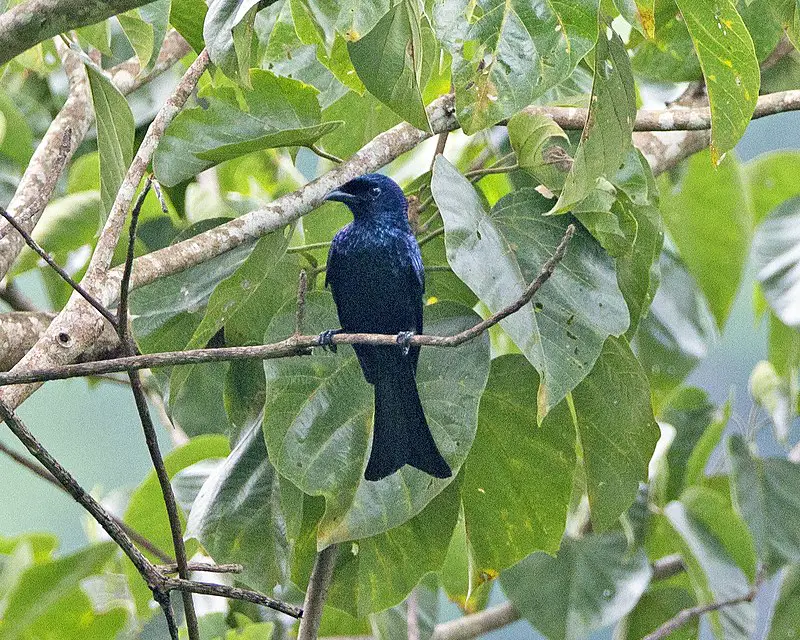
The Balicassiao bird is a notable passerine species endemic to the Philippines. These medium-sized birds have subtle physical differences depending on their race, with abraensis being the largest and either completely black or having a white lower breast and belly in mirabilis.
Balicassiaos can be found in subtropical or tropical moist lowland forests, and are well adapted to these environments.
Despite not being particularly visually striking or well-known, these birds play an important role in their ecosystem as they help to control the insect population.
Moreover, the Balicassiao bird has long been a subject of interest for zoologists, with French researchers first describing the species in 1760.Scientific classification:
| Kingdom | Animalia |
| Phylum | Chordata |
| Class | Aves |
| Order | Passeriformes |
| Family | Dicruridae |
| Genus | Dicrurus |
| Species | D. balicassius |
42. Philippine Coucal
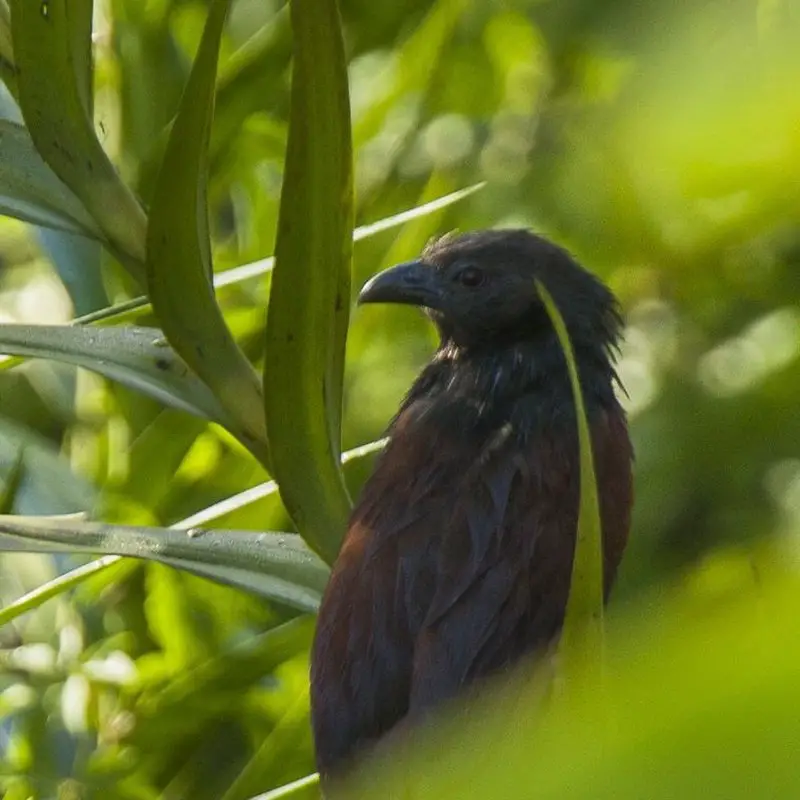
The Philippine coucal bird is a type of cuckoo found exclusively in the Philippines. This medium-sized bird has similar physical characteristics for both males and females, while different races of this species vary in color and size.
Some races, such as the carpenteri and mindorensis, appear completely black, while others like the viridis and majer display a black body with chestnut-colored wings. The carpenteri and majer variants are larger than viridis and mindorensis.
The viridis type possesses an overall black appearance, accented with a green sheen. As an endemic species, the Philippine coucal is only found in the Philippines, making it an important part of the country’s biodiversity.
Despite being a relatively lesser-known species compared to other birds, the Philippine coucal proves to be an interesting representative of avian life in the country.Scientific classification:
| Kingdom | Animalia |
| Phylum | Chordata |
| Class | Aves |
| Order | Cuculiformes |
| Family | Cuculidae |
| Genus | Centropus |
| Species | C. viridis |
Also Featured In: Most Common Catanduanes Birds,
43. Mangrove Blue Flycatcher
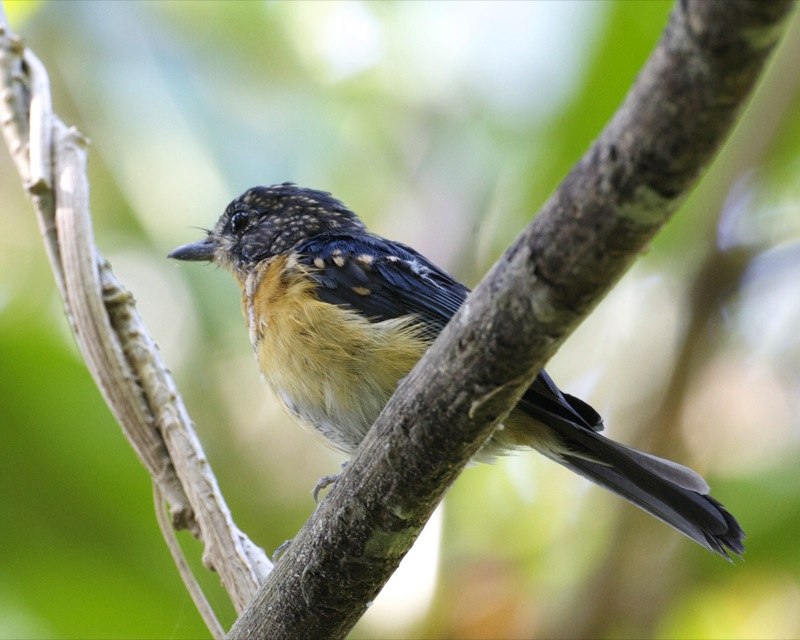
The Mangrove Blue Flycatcher is a bird belonging to the family Muscicapidae. It can be found in various countries including Brunei, Indonesia, Malaysia, Sri Lanka, and Thailand.
This bird typically resides in subtropical or tropical mangrove forests. The Kalao blue flycatcher is split into a different species according to some experts.
However, the IOC still considers it to be a subspecies of the Mangrove Blue Flycatcher.Scientific classification:
| Kingdom | Animalia |
| Phylum | Chordata |
| Class | Aves |
| Order | Passeriformes |
| Family | Muscicapidae |
| Genus | Cyornis |
| Species | C. rufigastra |
44. White-Bellied Munia
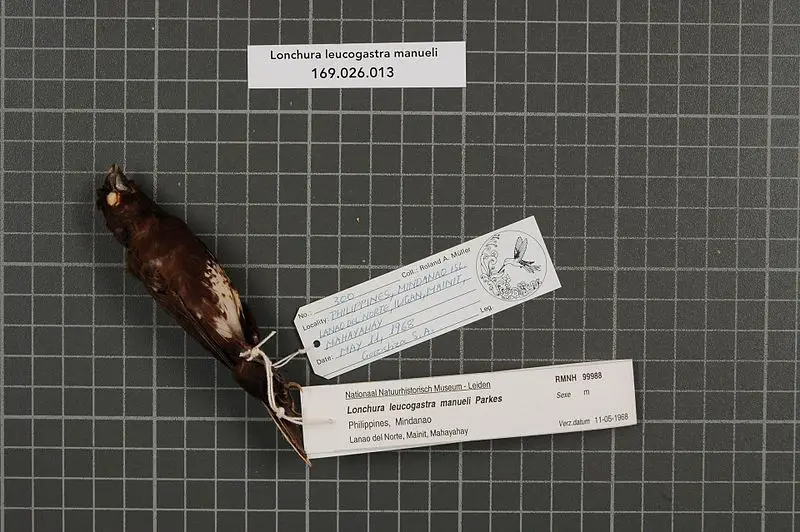
The White-bellied Munia is a finch species that can be found in the Malesia region. It is known for its white belly which gives it its name. This bird’s natural habitat is in subtropical and tropical lowland moist forests.
Despite habitat loss and degradation, the species is currently evaluated as Least Concern.
The White-bellied Munia’s diet consists of seeds and insects, and they are known to live in flocks. They are active during the day and communicate with soft chirps and calls.
The male and female have similar appearance, with a brown body and a white belly, but the male is slightly larger. While they are not commonly kept as pets, some people enjoy watching them in aviaries.
Overall, the White-bellied Munia is a unique and interesting bird species found in lush, forested habitats.Scientific classification:
| Kingdom | Animalia |
| Phylum | Chordata |
| Class | Aves |
| Order | Passeriformes |
| Family | Estrildidae |
| Genus | Lonchura |
| Species | L. leucogastra |
45. Bicolored Flowerpecker
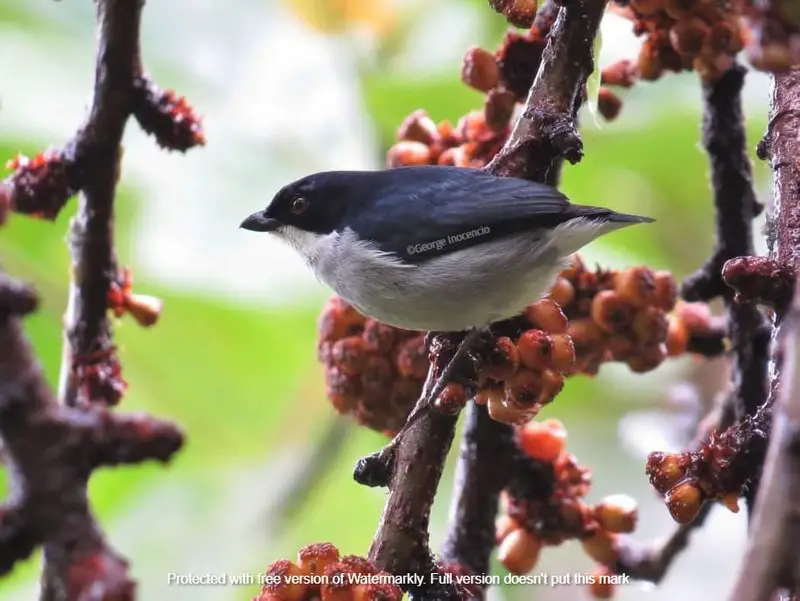
The Bicolored flowerpecker is a tiny bird that is native to the Philippines. They can be found in tropical forests and sometimes venture up to 2,250 meters above sea level.
They often roam in mixed flocks of other small birds, such as white-eyes and sunbirds. This species is known for their vibrant two-tone feathers and their unique beak shape, which is perfect for eating nectar and fruits.
Despite their small size, they are energetic creatures that flit around the trees and bushes looking for snacks. The Bicolored flowerpecker plays a vital role in their ecosystem by helping to pollinate flowers and disperse seeds.
It is a pleasure to catch a glimpse of these stunningly colorful birds when exploring the forests of the Philippines.Scientific classification:
| Kingdom | Animalia |
| Phylum | Chordata |
| Class | Aves |
| Order | Passeriformes |
| Family | Dicaeidae |
| Genus | Dicaeum |
| Species | D. bicolor |
46. Pygmy Flowerpecker
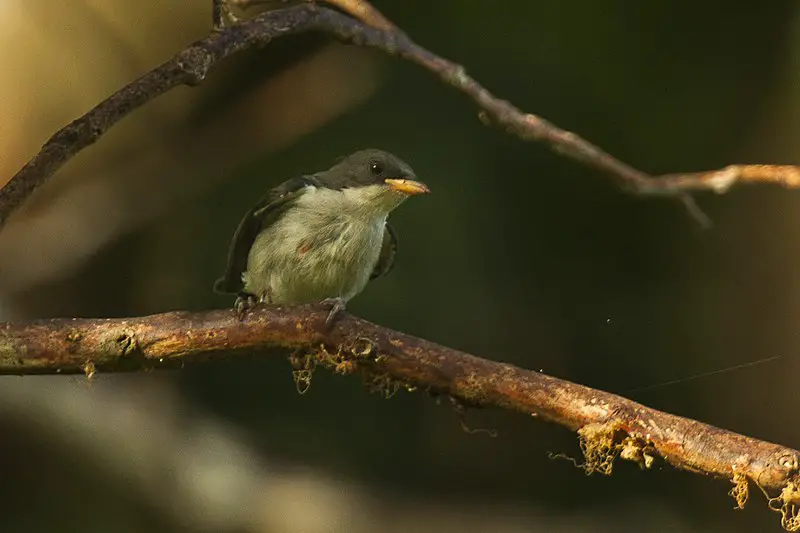
The tiny Pygmy flowerpecker is a unique bird species found only in the Philippines. They prefer to inhabit moist forests, both lowland and montane. With their size, they are easily overlooked as they blend in with the surrounding foliage.
These little birds have a distinctive black cap and upperparts that contrast against their striking red underparts.
They are known to feed on nectar and small insects. Despite their small size, they have a loud and sharp voice that can be heard during their courtship displays.
Unfortunately, the Pygmy flowerpecker faces threats from habitat loss due to deforestation, which makes preserving their habitats crucial for their survival.
Overall, these little birds are a valuable species in the Philippines, adding to the biodiversity of the country’s rich ecosystem.Scientific classification:
| Kingdom | Animalia |
| Phylum | Chordata |
| Class | Aves |
| Order | Passeriformes |
| Family | Dicaeidae |
| Genus | Dicaeum |
| Species | D. pygmaeum |
47. Little Pied Flycatcher
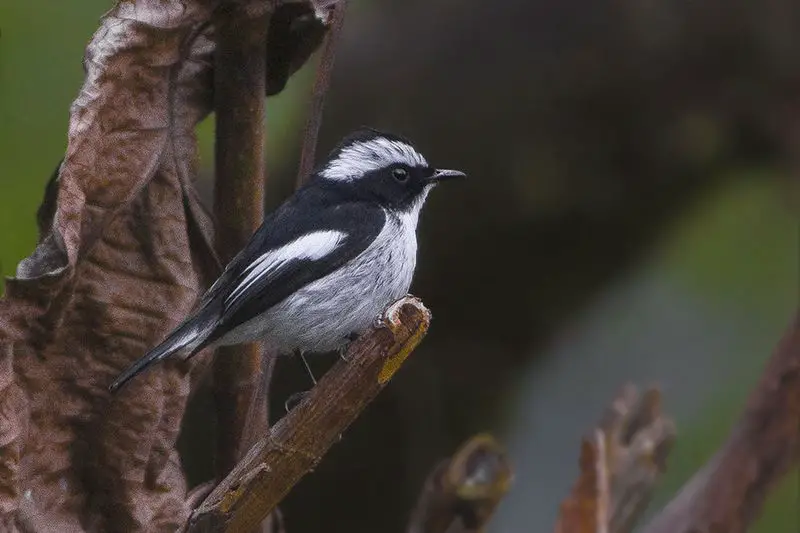
The Little Pied Flycatcher is a bird that belongs to the family Muscicapidae. This species can be found in several countries in Southeast Asia and the Indian Subcontinent.
Its natural habitats include subtropical or tropical moist lowland forests and moist moors. This bird is relatively small in size and has distinct black and white markings on its body.
It feeds primarily on insects and can often be seen quickly darting through the air to catch its prey. Despite its small size, this bird is known for its beautiful singing voice, which can often be heard echoing through its natural habitats.
Overall, the Little Pied Flycatcher is a charming bird species that adds to the biodiversity found in its range of habitat.Scientific classification:
| Kingdom | Animalia |
| Phylum | Chordata |
| Class | Aves |
| Order | Passeriformes |
| Family | Muscicapidae |
| Genus | Ficedula |
| Species | F. westermanni |
48. Philippine Oriole
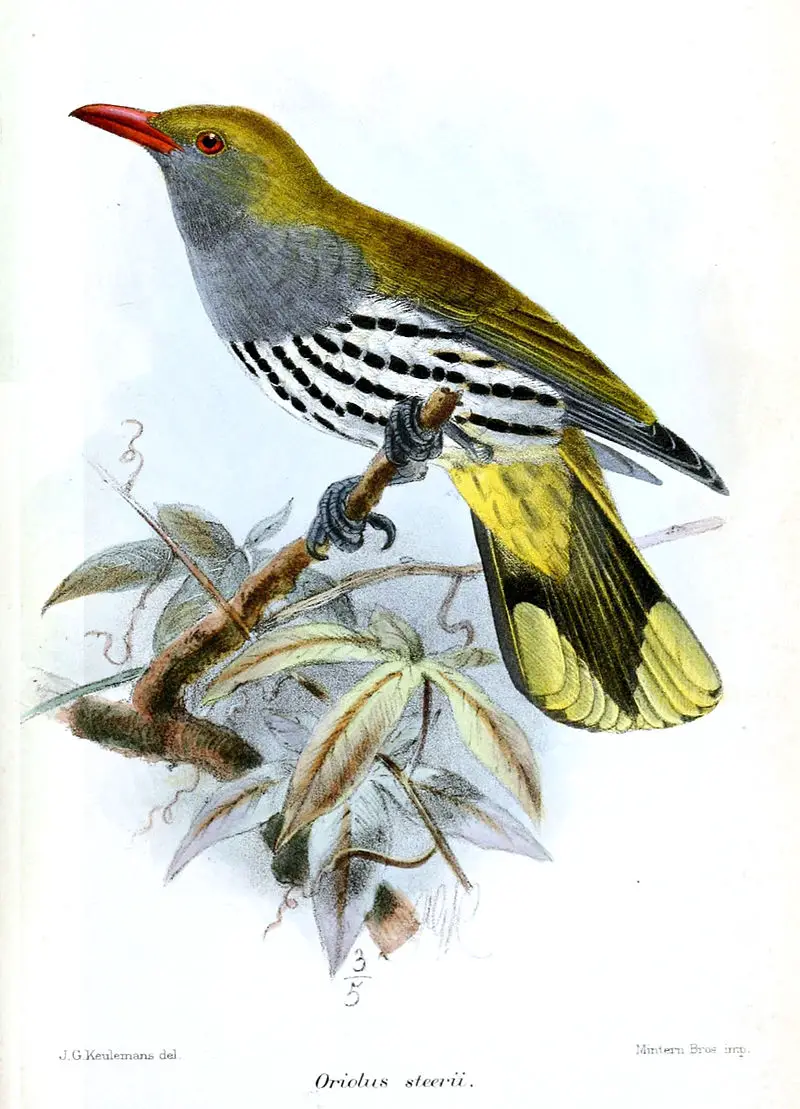
The Philippine oriole bird, also known as the grey-throated oriole, is a unique species that can only be found in the Philippines. Its natural habitat includes subtropical or tropical moist lowland forests.
Although fairly common throughout its range, the Cebu race of the bird has sadly become extinct after the last sighting was recorded in 1906. This species of bird is known for its beautiful colours and distinctive singing voice.
Studies of the Philippine oriole have shown that it plays an important role in maintaining the balance of the forest ecosystem.
The bird has become an important symbol for conservation efforts in the Philippines, as it represents the importance of preserving unique and rare species.
Despite the challenges that the Philippine oriole has faced, there are still efforts being made to protect and preserve this beautiful bird for generations to come.Scientific classification:
| Kingdom | Animalia |
| Phylum | Chordata |
| Class | Aves |
| Order | Passeriformes |
| Family | Oriolidae |
| Genus | Oriolus |
| Species | O. steerii |
49. Yellowish White-Eye
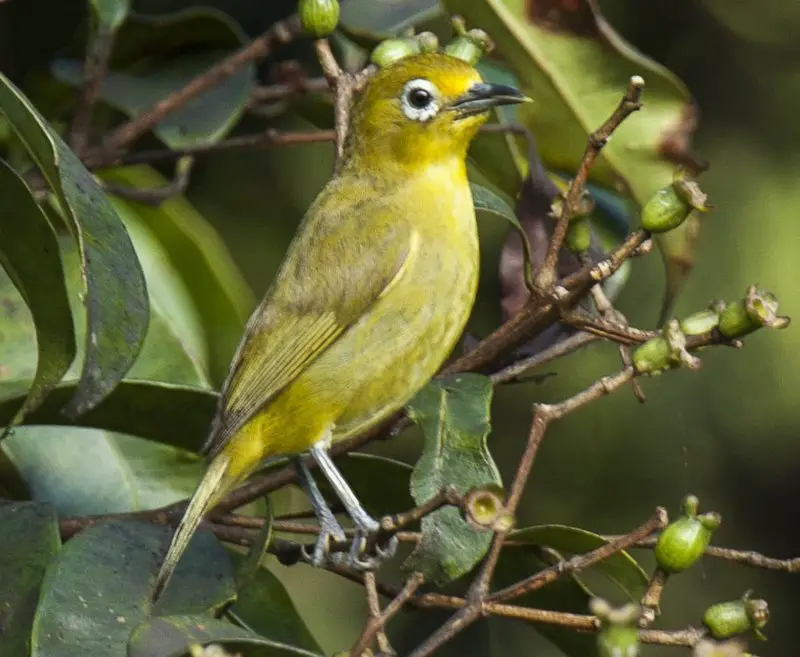
The Yellowish white-eye is a bird that can be found exclusively in the Philippines. This species belongs to the Zosteropidae family and is also known as the golden-yellow white-eye.
Their natural habitat is tropical forests with a moist, lowland environment. With their striking yellow feathers and small size, these birds are a fascinating sight to behold. They are highly adaptable and have been known to feed on insects and fruits.
The Yellowish white-eye has a unique song that is often used for communication among other members of their flock. Though they are not considered to be threatened, deforestation and habitat loss pose a threat to their survival.
These delicate and fascinating birds continue to draw attention and garner interest from bird enthusiasts around the world.Scientific classification:
| Kingdom | Animalia |
| Phylum | Chordata |
| Class | Aves |
| Order | Passeriformes |
| Family | Zosteropidae |
| Genus | Zosterops |
| Species | Z. nigrorum |
50. Malaysian Plover
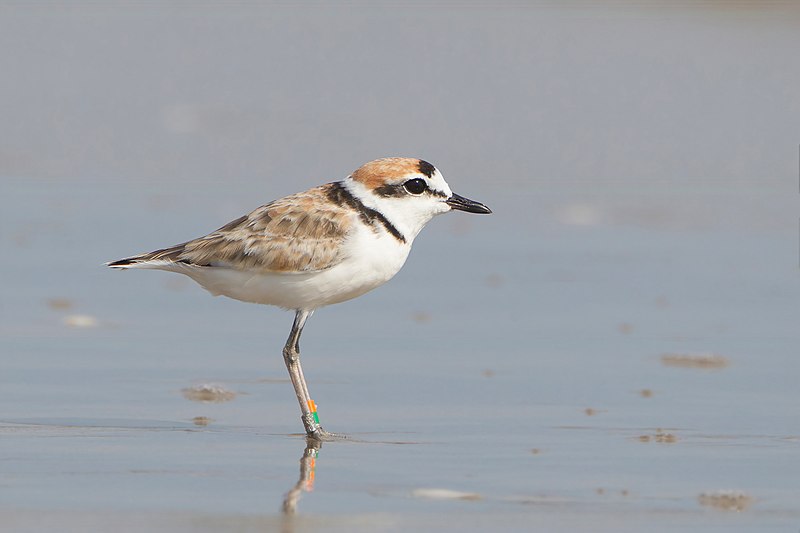
The Malaysian plover is a small wading bird found in Southeast Asia. It has a black or brown band around its neck, which varies by gender. The bird’s legs are pale and its voice is soft.
It nests on beaches and salt flats, laying two to five cryptic eggs. This bird is about 15 cm long, weighing around 35-42 g. The Malaysian plover’s diet consists of insects, crustaceans, and mollusks.
Despite being a small bird, it has a strong instinct to protect its nest and young from predators. The conservation status of the Malaysian plover is classified as Near Threatened due to the degradation of its coastal habitat caused by human activities.
Efforts are being made to protect and conserve the species.Scientific classification:
| Kingdom | Animalia |
| Phylum | Chordata |
| Class | Aves |
| Order | Charadriiformes |
| Family | Charadriidae |
| Genus | Charadrius |
| Species | C. peronii |
51. Blue-Naped Parrot
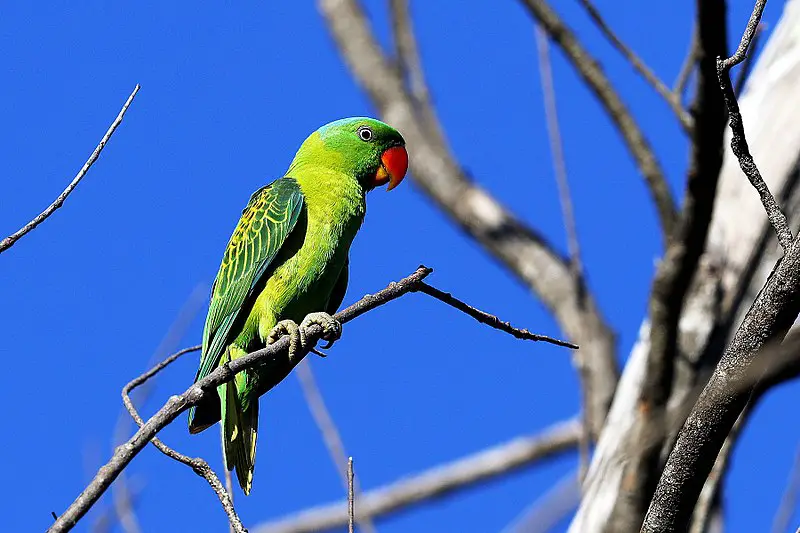
The Blue-naped parrot is a species of parrot found all over the Philippines. It is also known as Luzon parrot, Blue-crowned green parrot, and Philippine green parrot.
The locals often call it “Pikoy.” The parrot has a distinctive blue patch on the back of its neck, which gives it its name. Its feathers are mostly green, and it has a red beak.
These birds are social creatures and can be found in flocks of up to 30 individuals. They are often seen in pairs or small groups.
The Blue-naped parrot is known for its ability to mimic human speech, making it a popular pet among bird enthusiasts.
However, they are also considered vulnerable due to habitat loss and poaching. Efforts are being made to protect the species and their habitats.Scientific classification:
| Kingdom | Animalia |
| Phylum | Chordata |
| Class | Aves |
| Order | Psittaciformes |
| Family | Psittaculidae |
| Genus | Tanygnathus |
| Species | T. lucionensis |